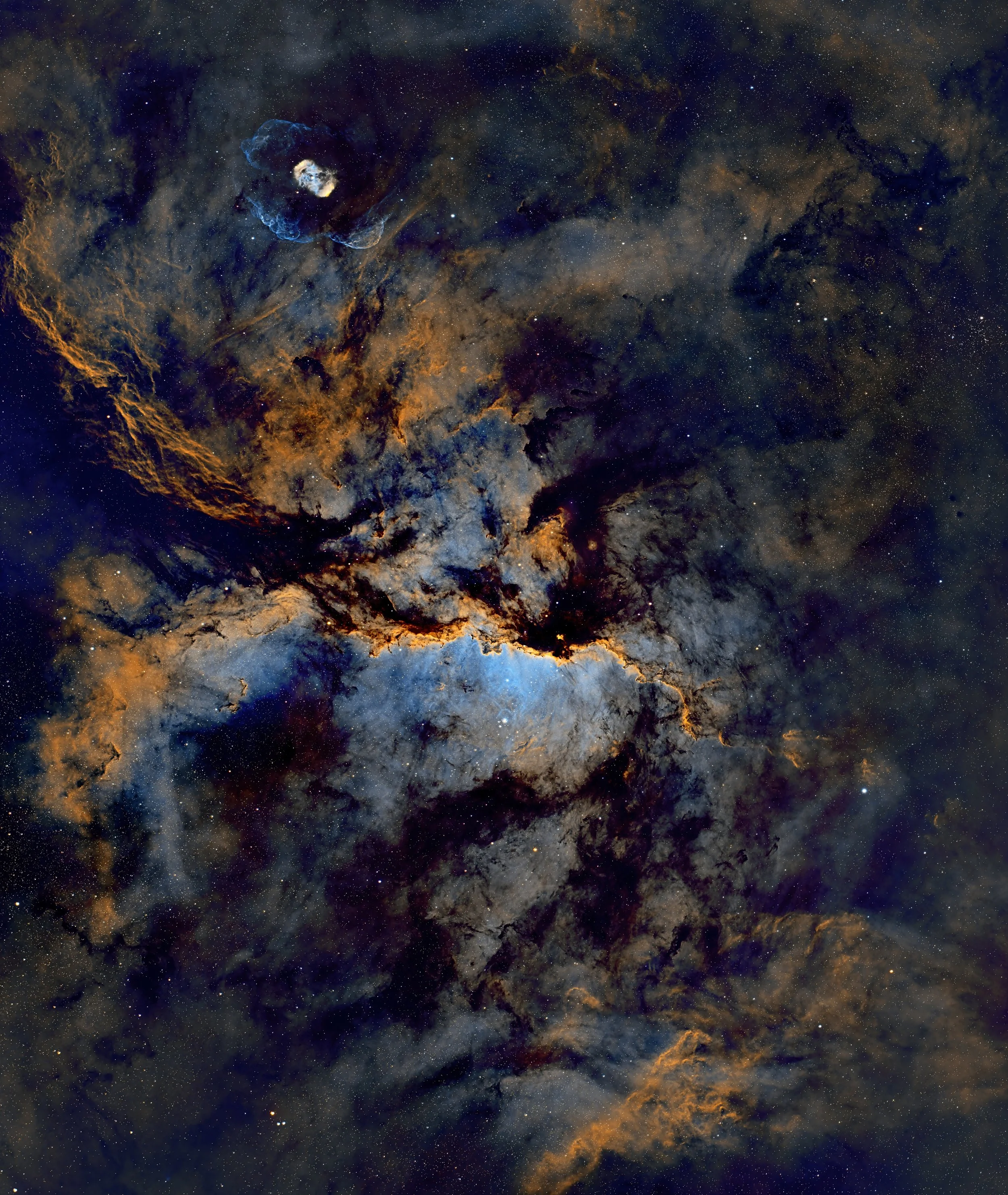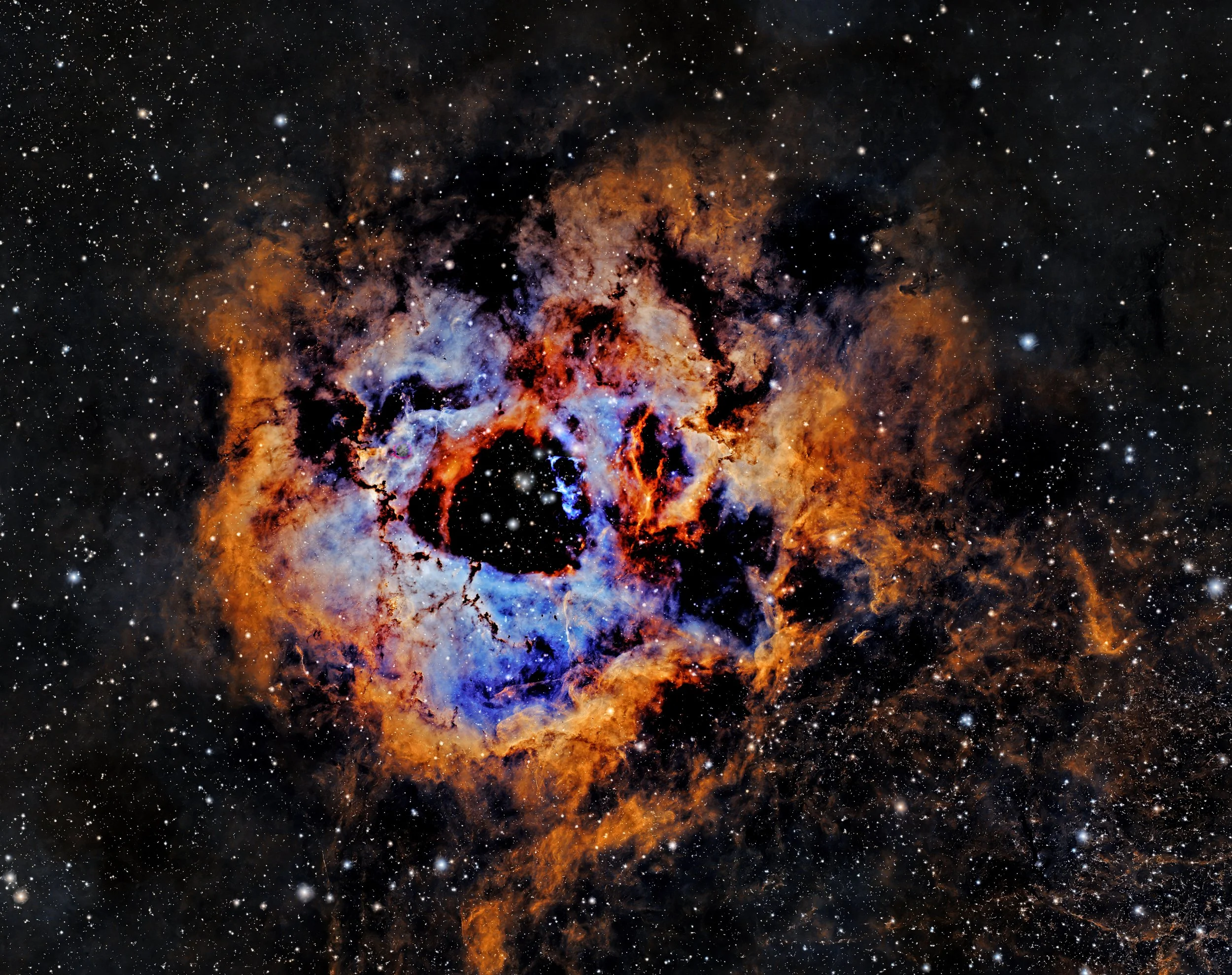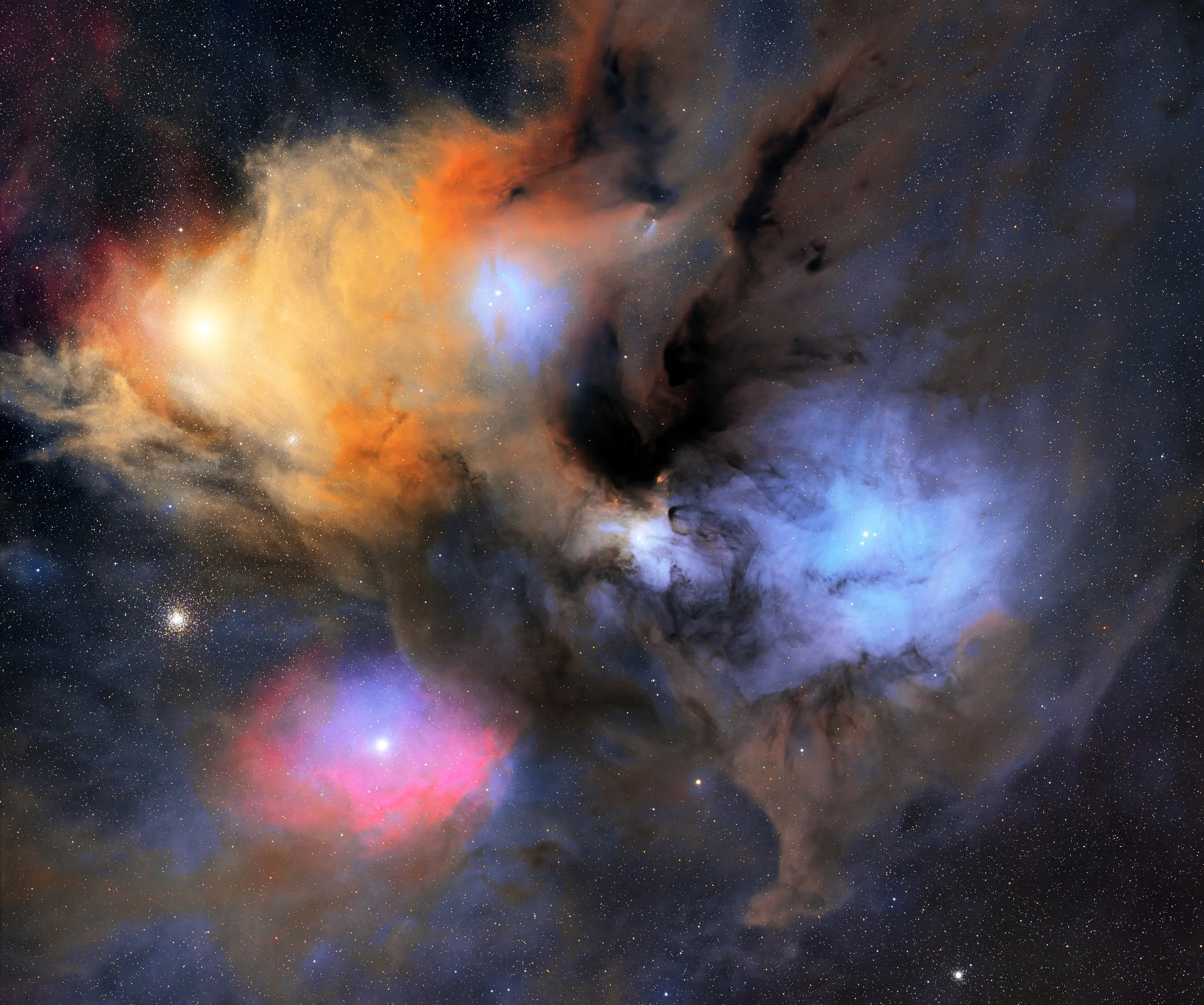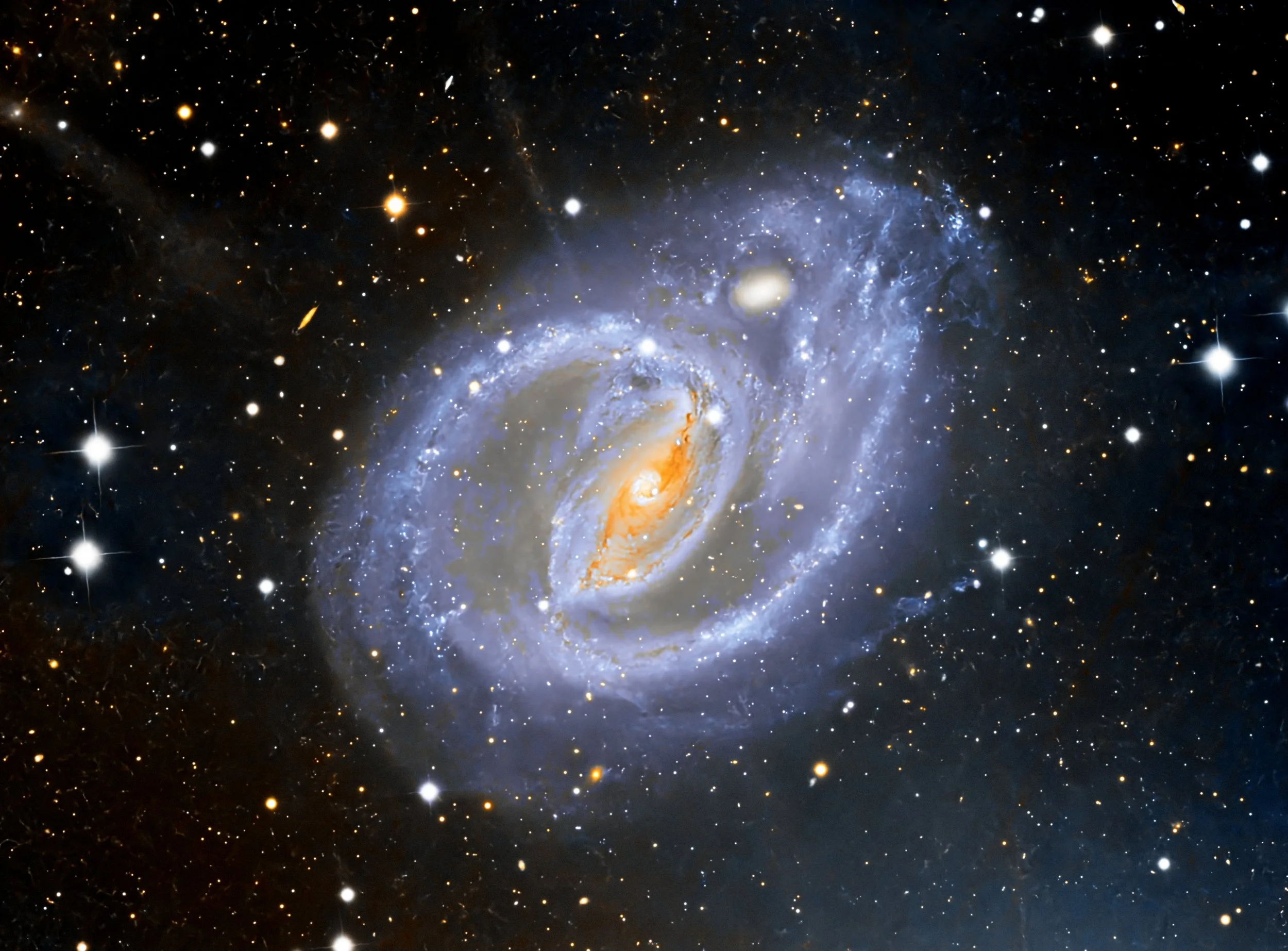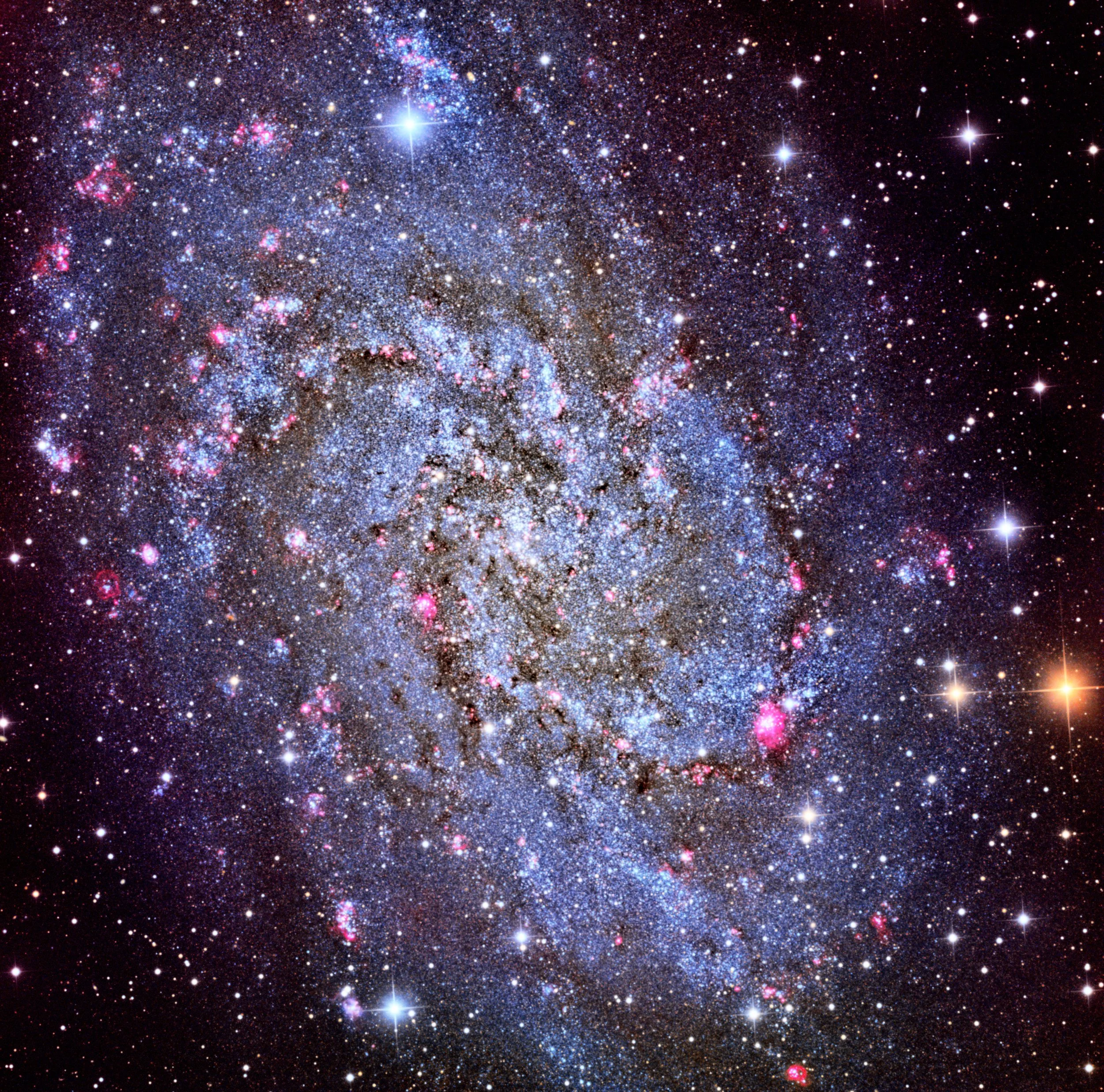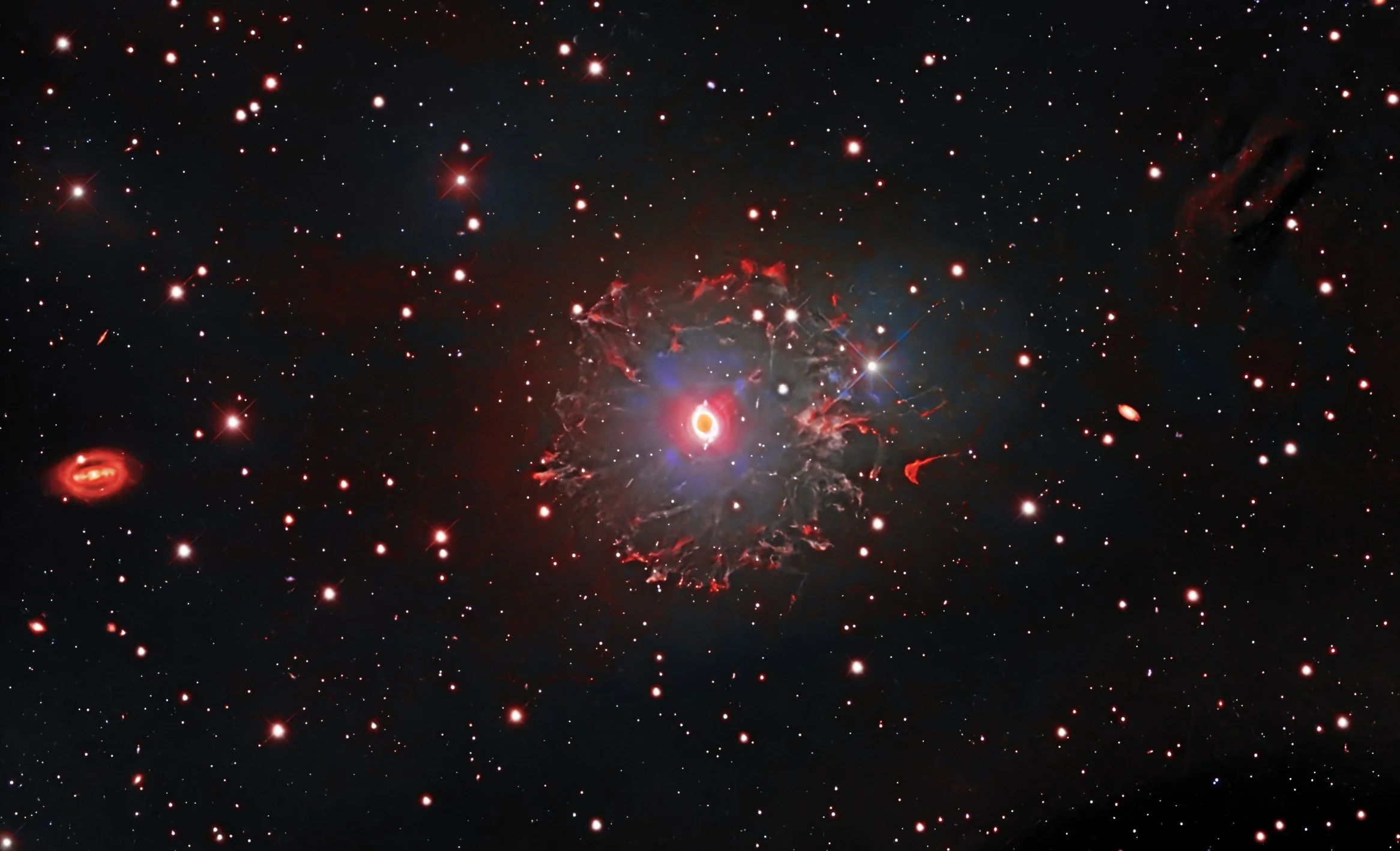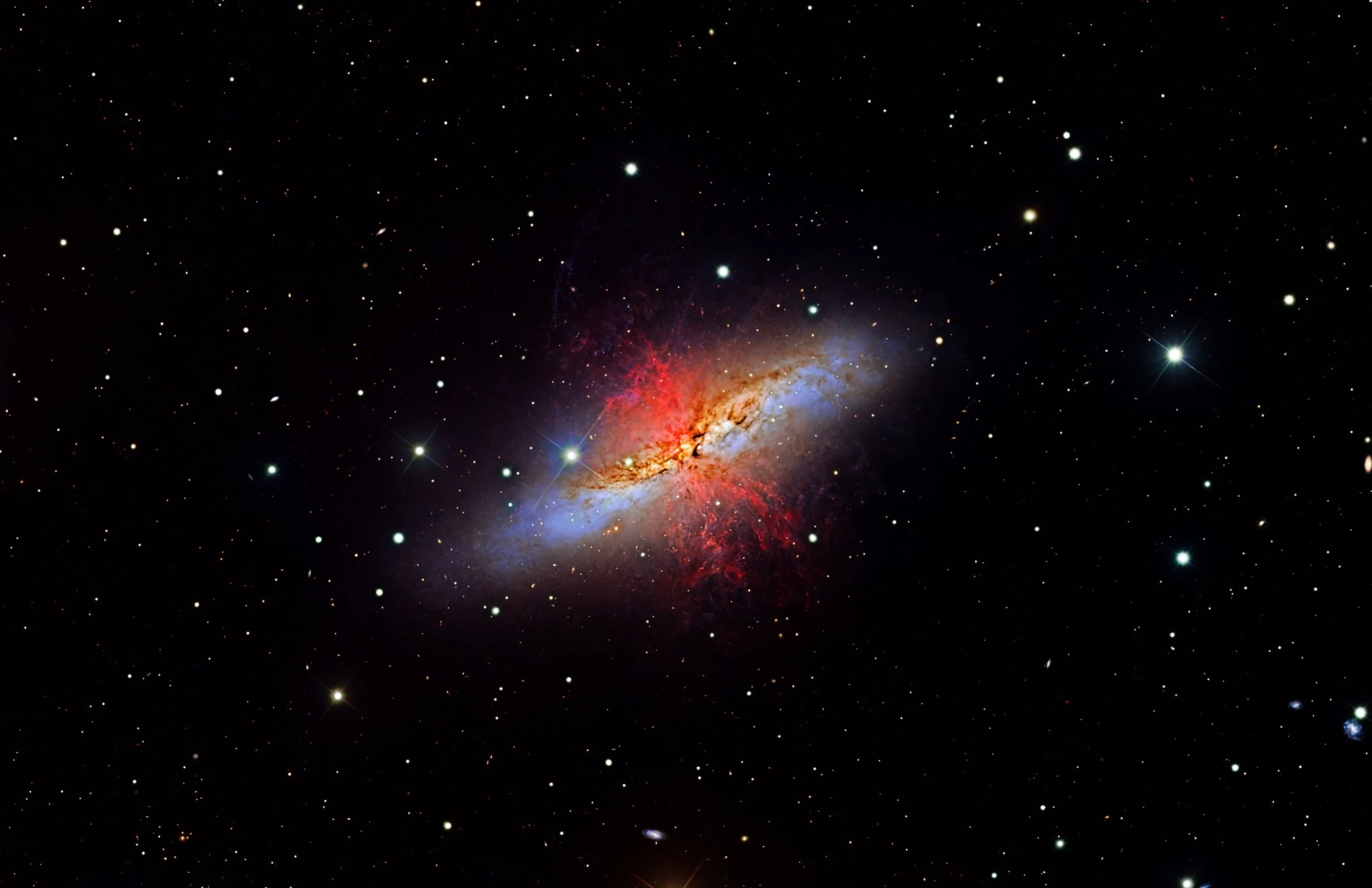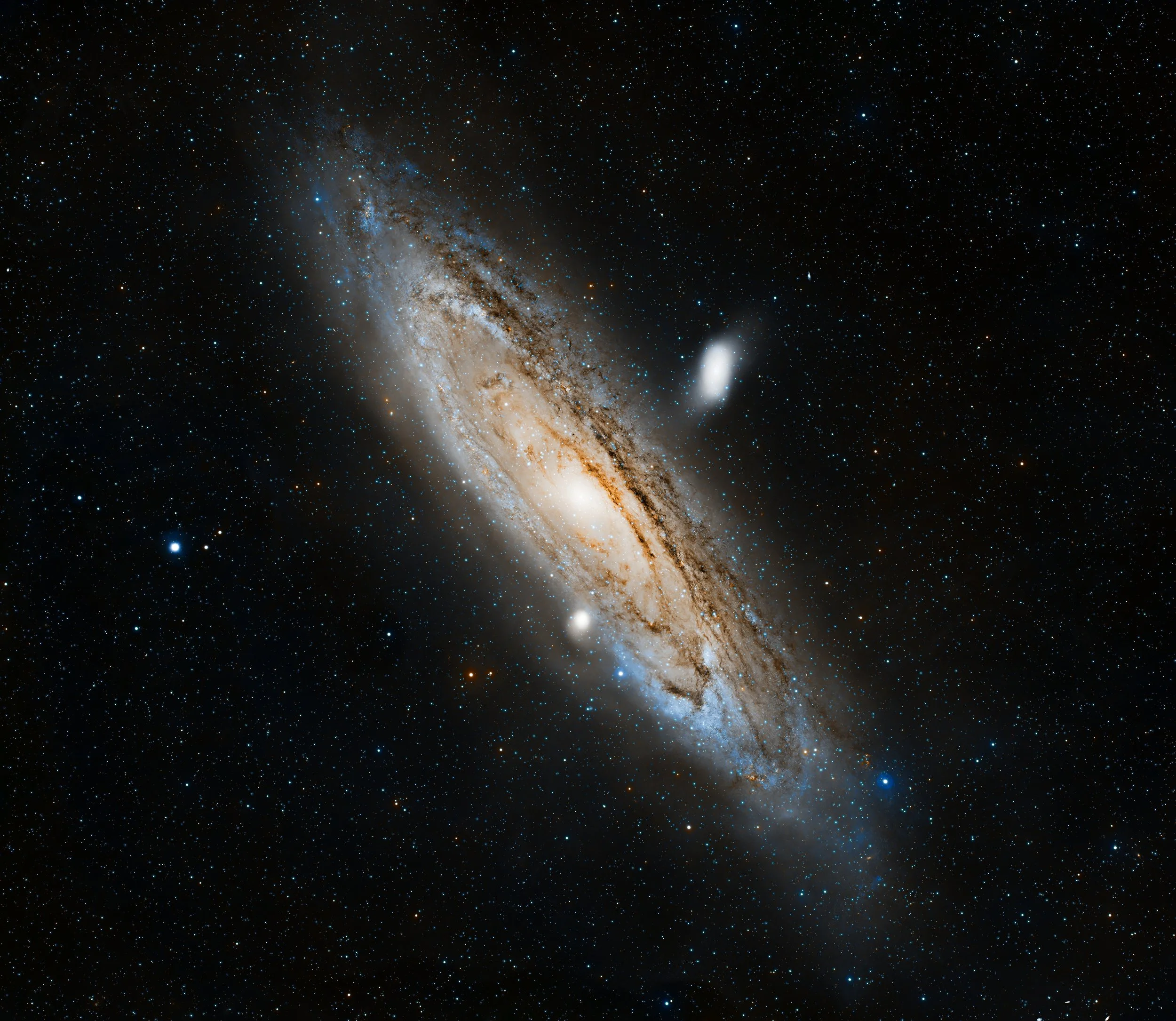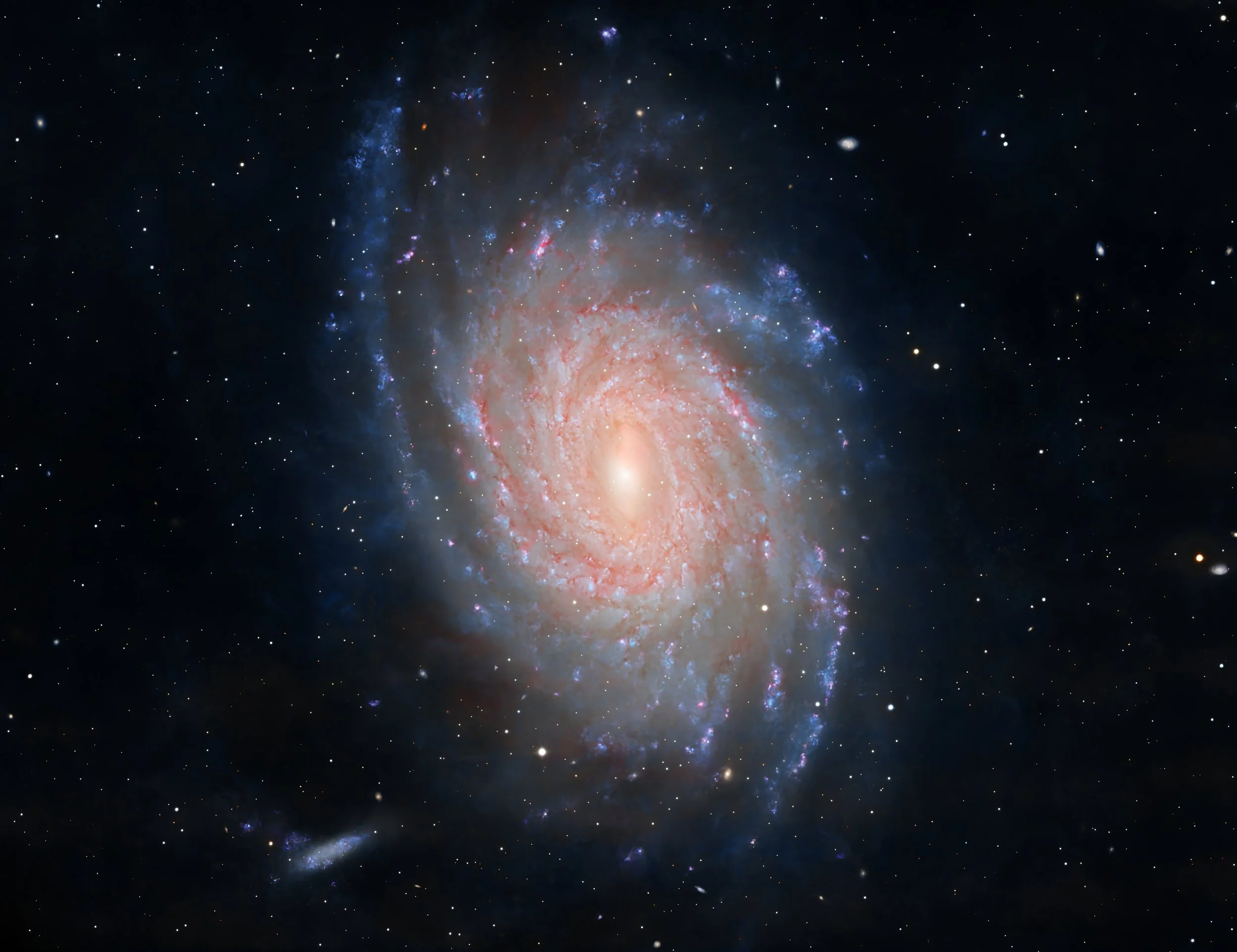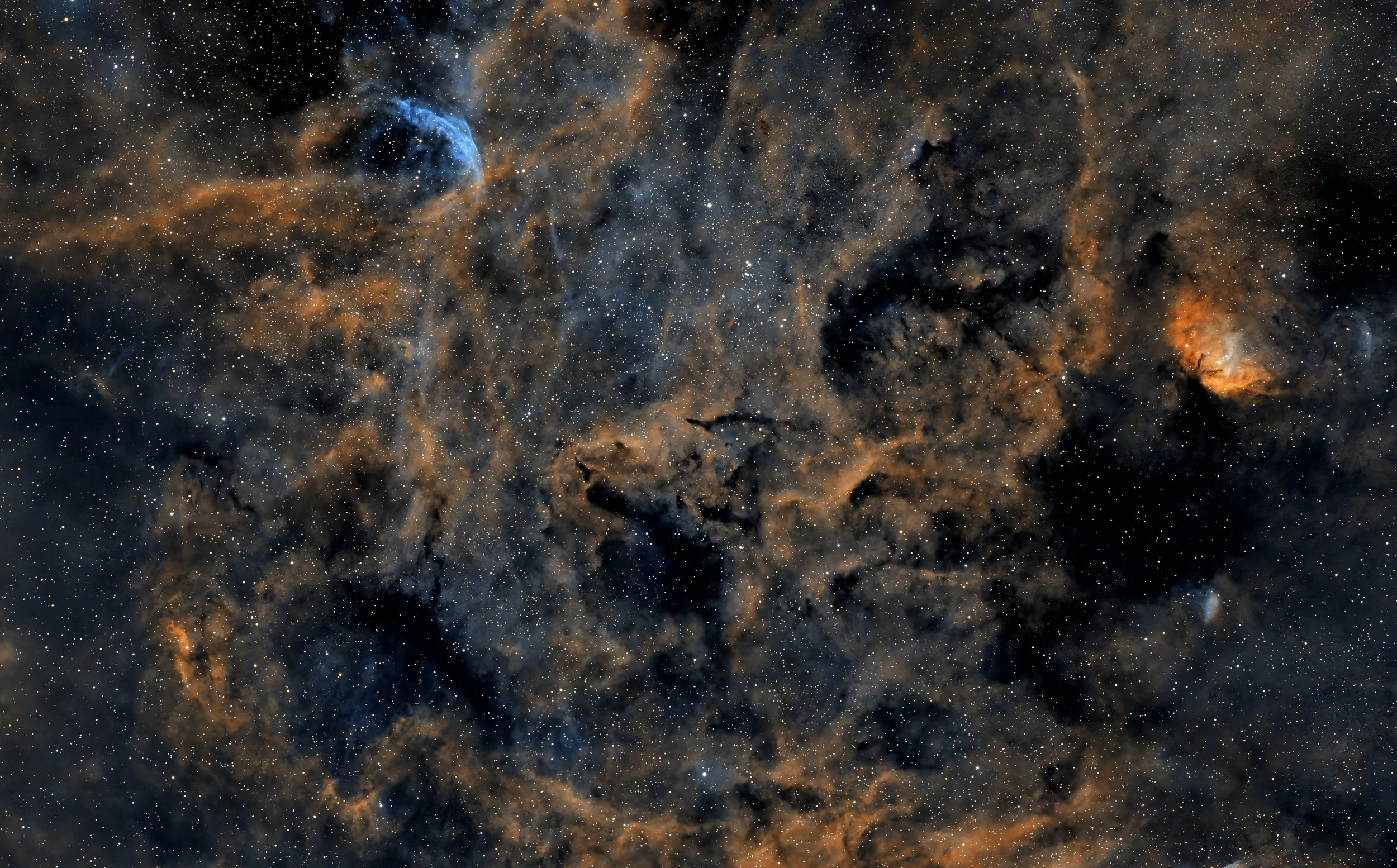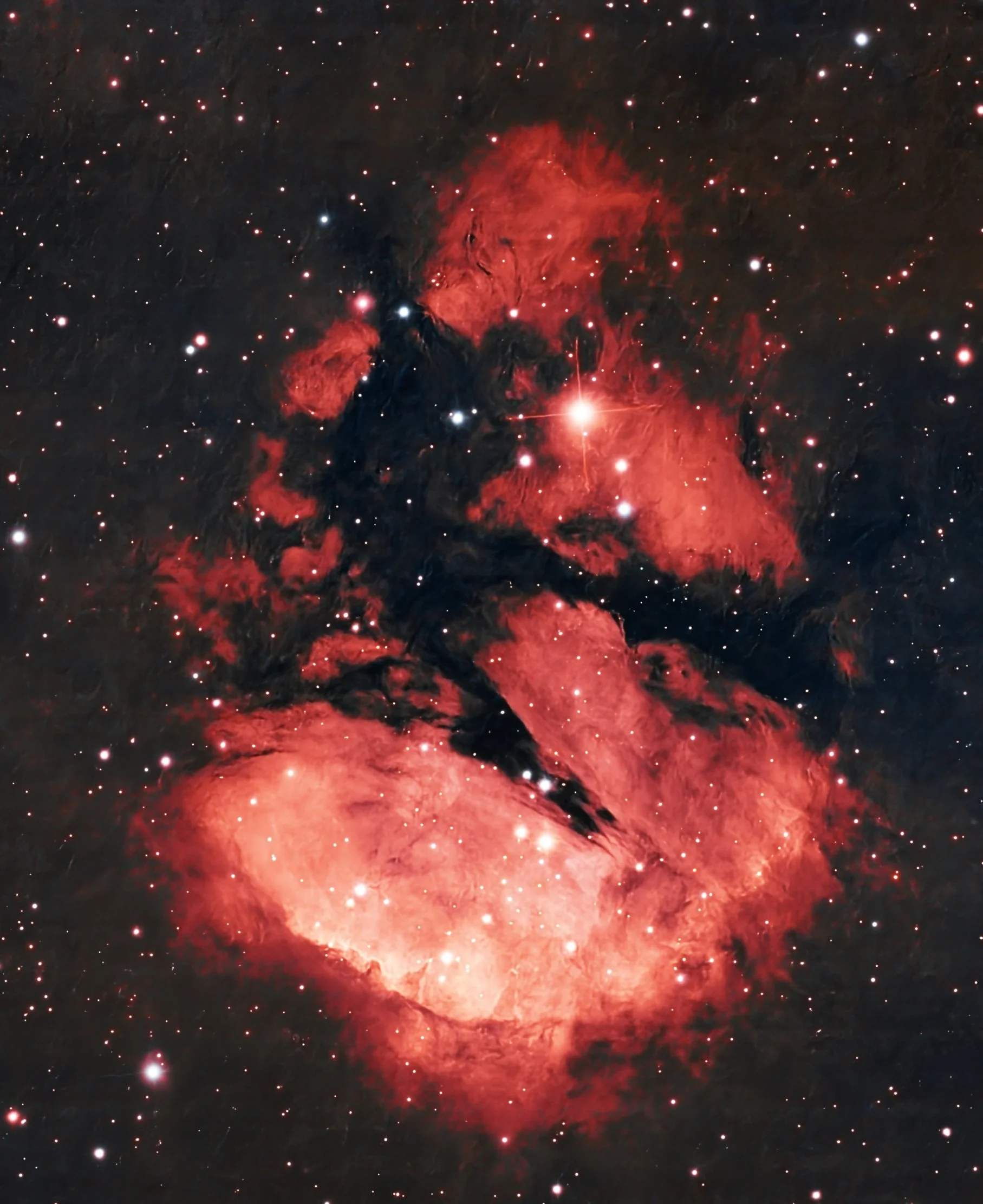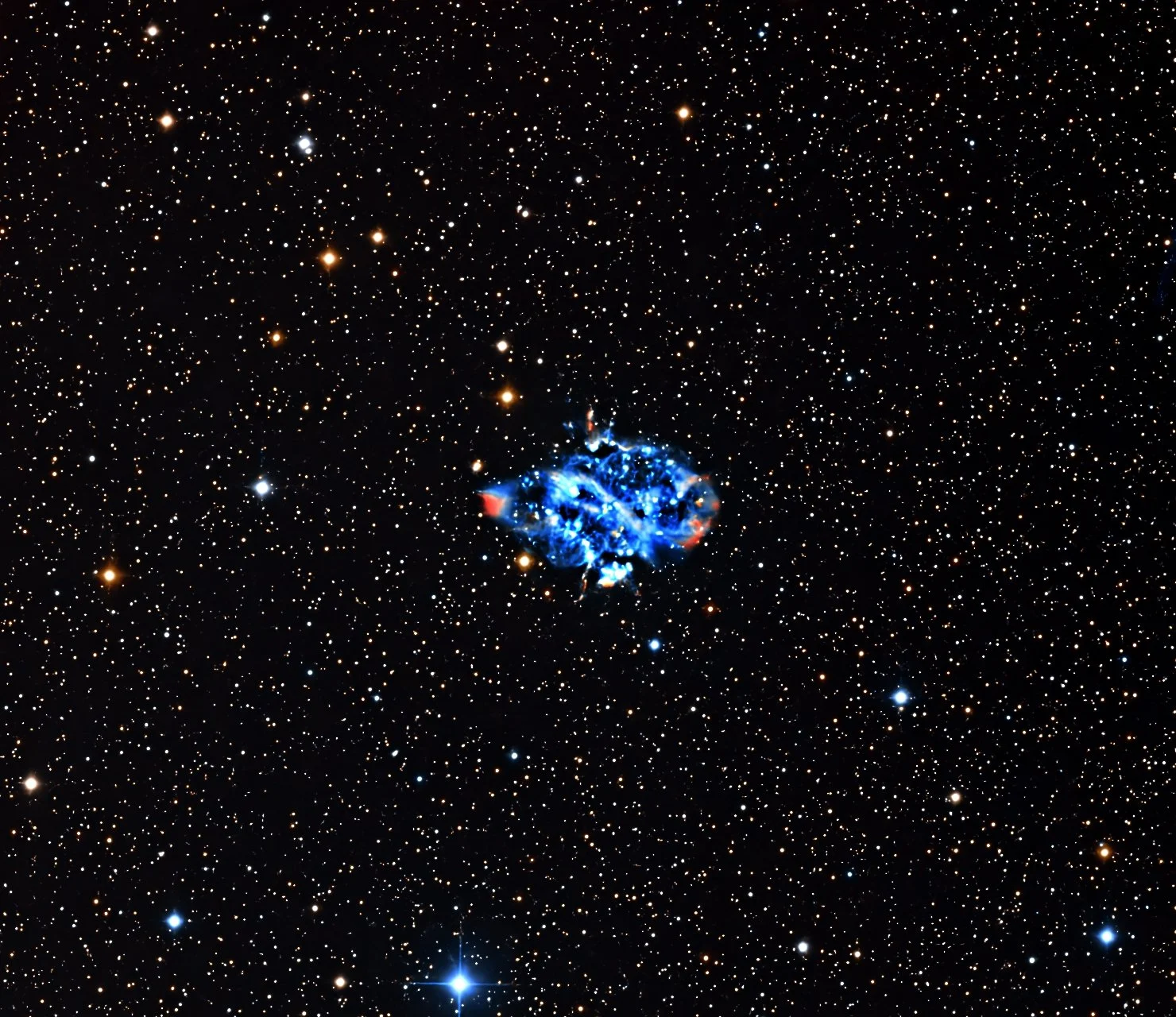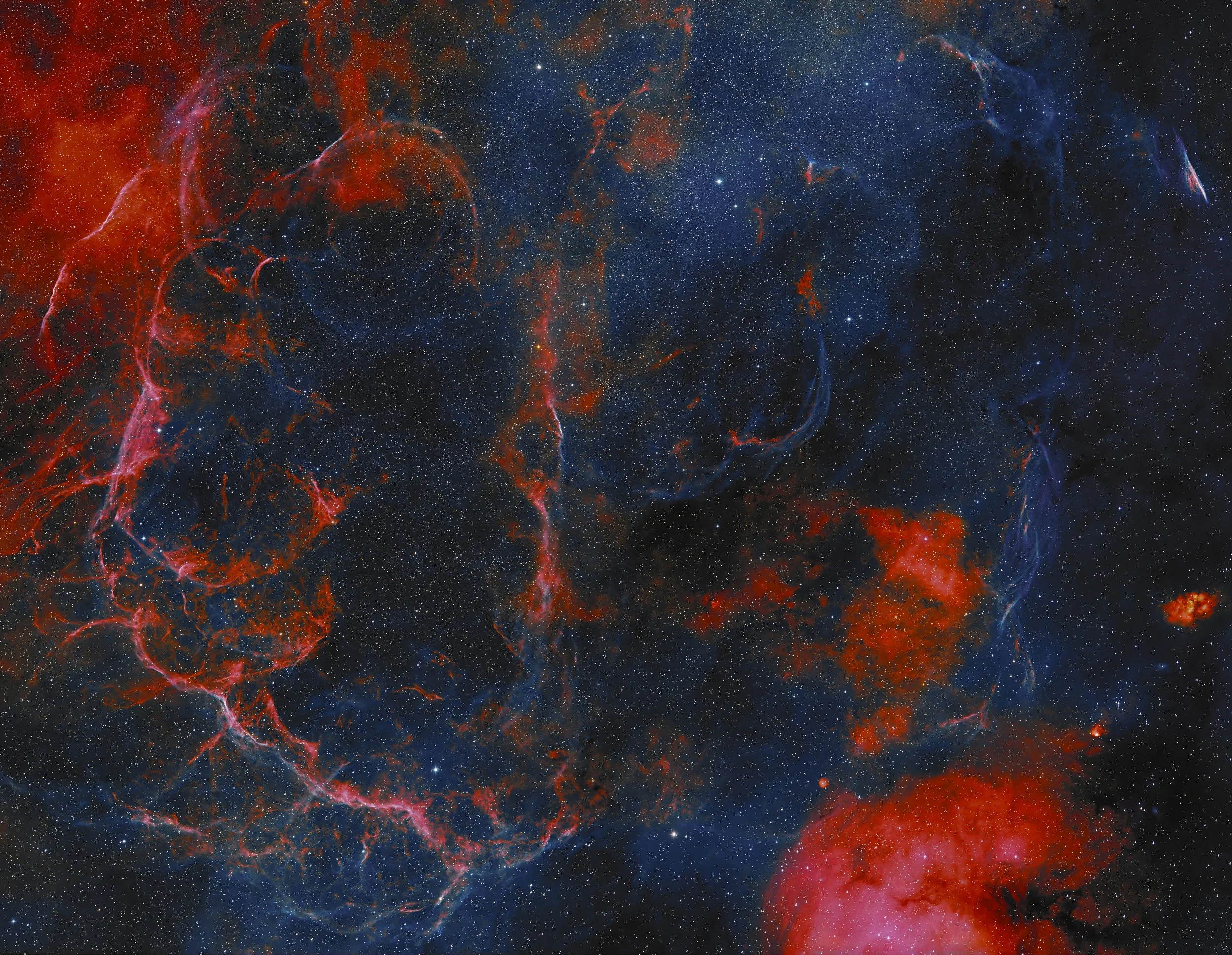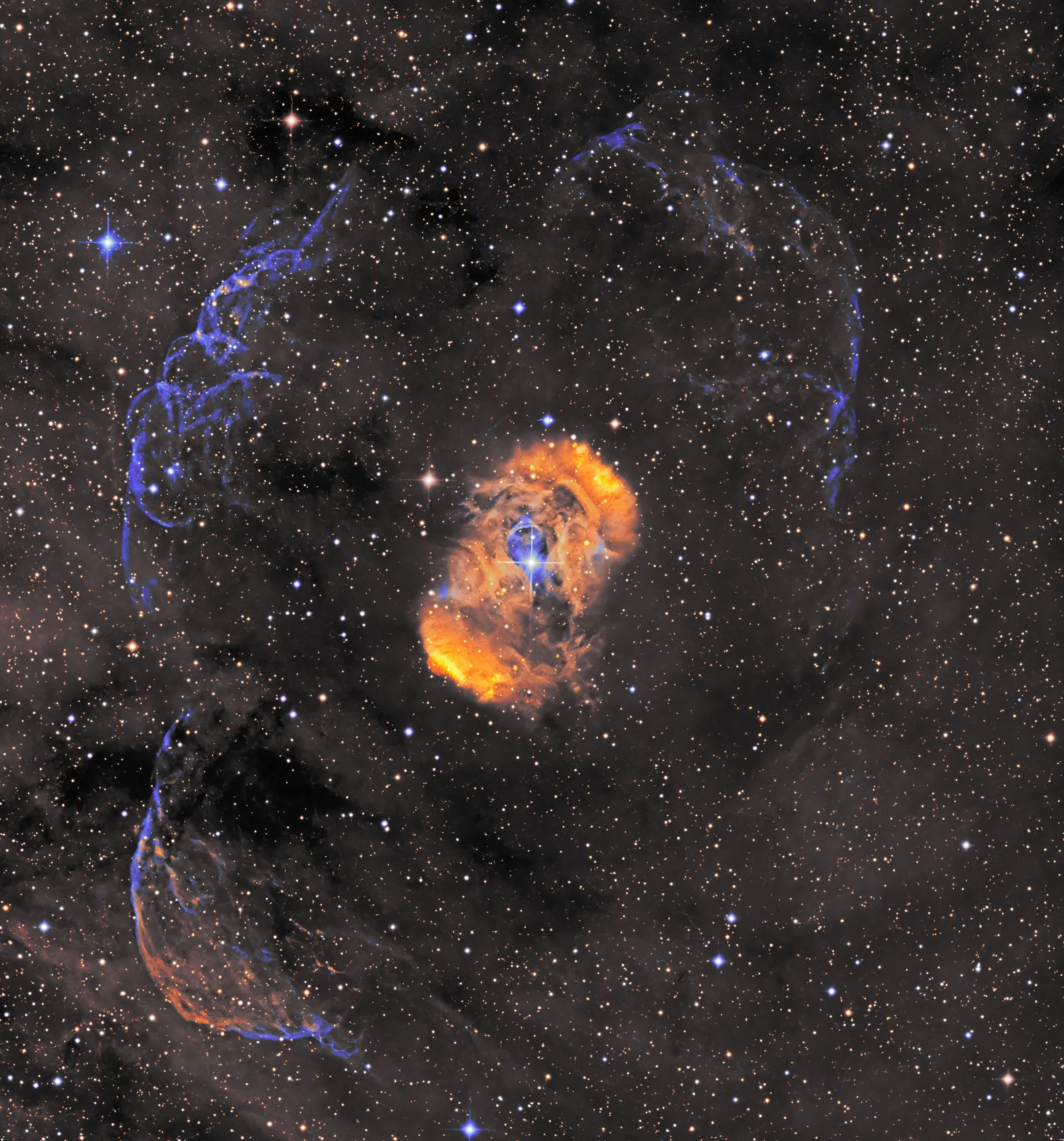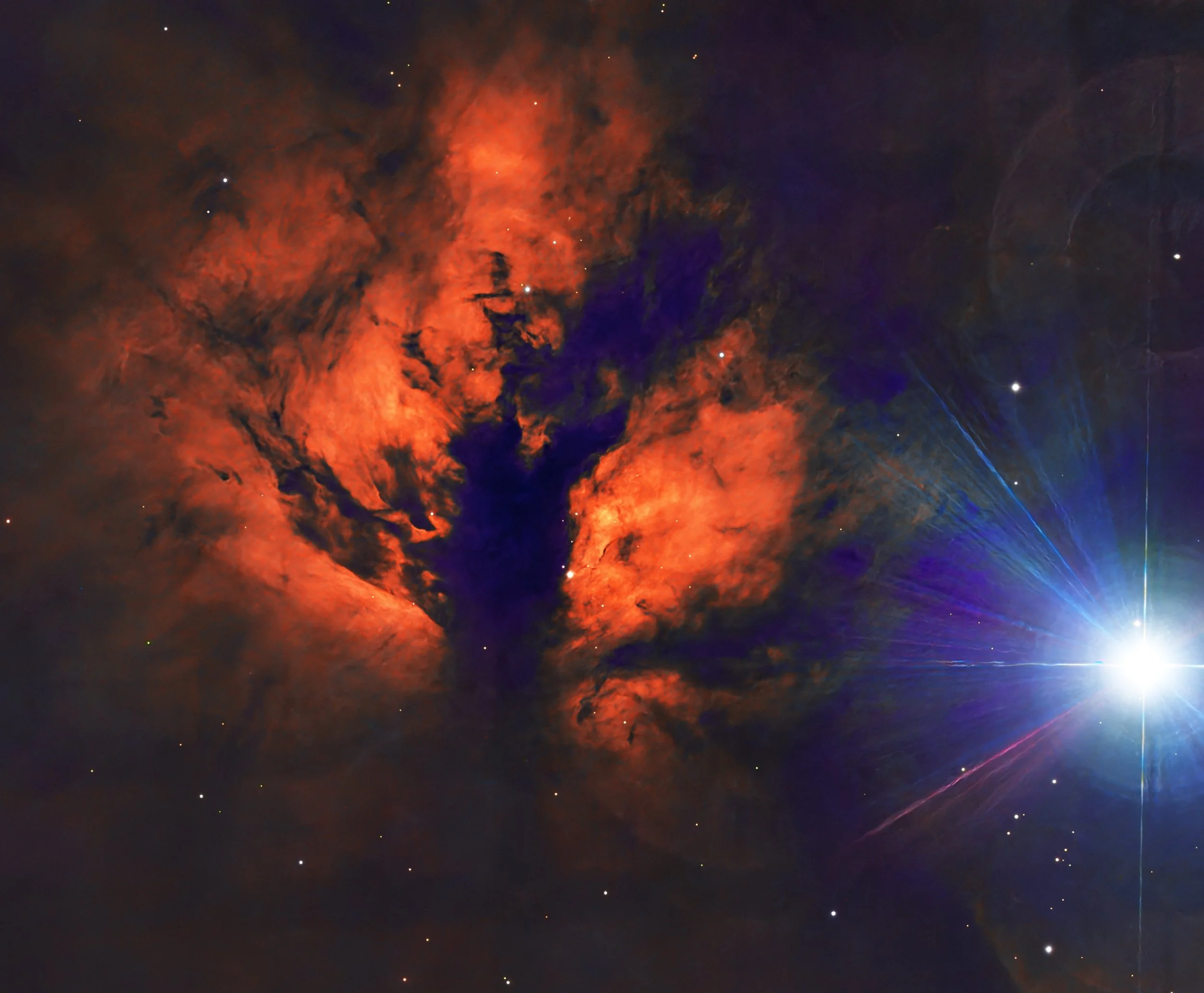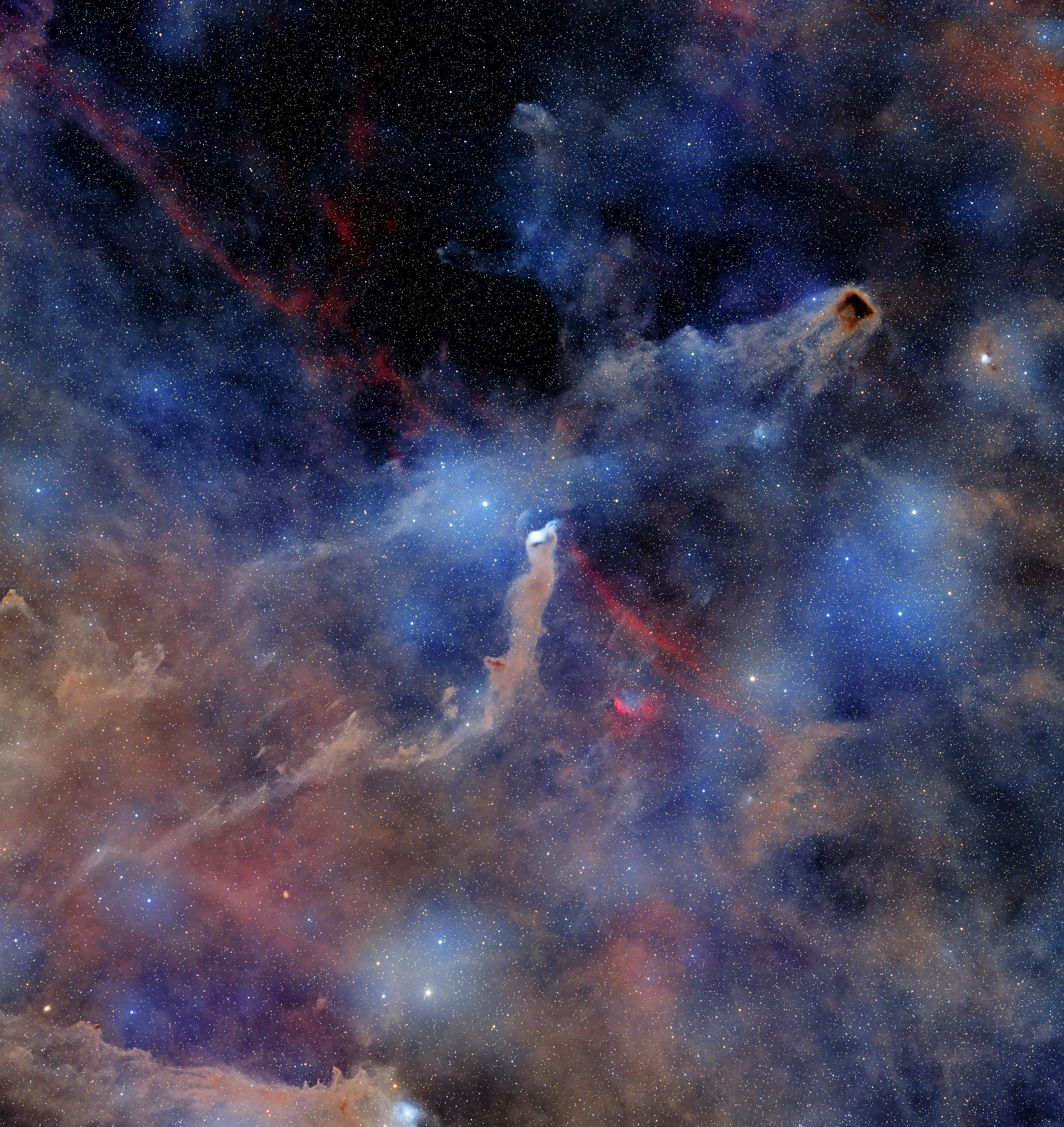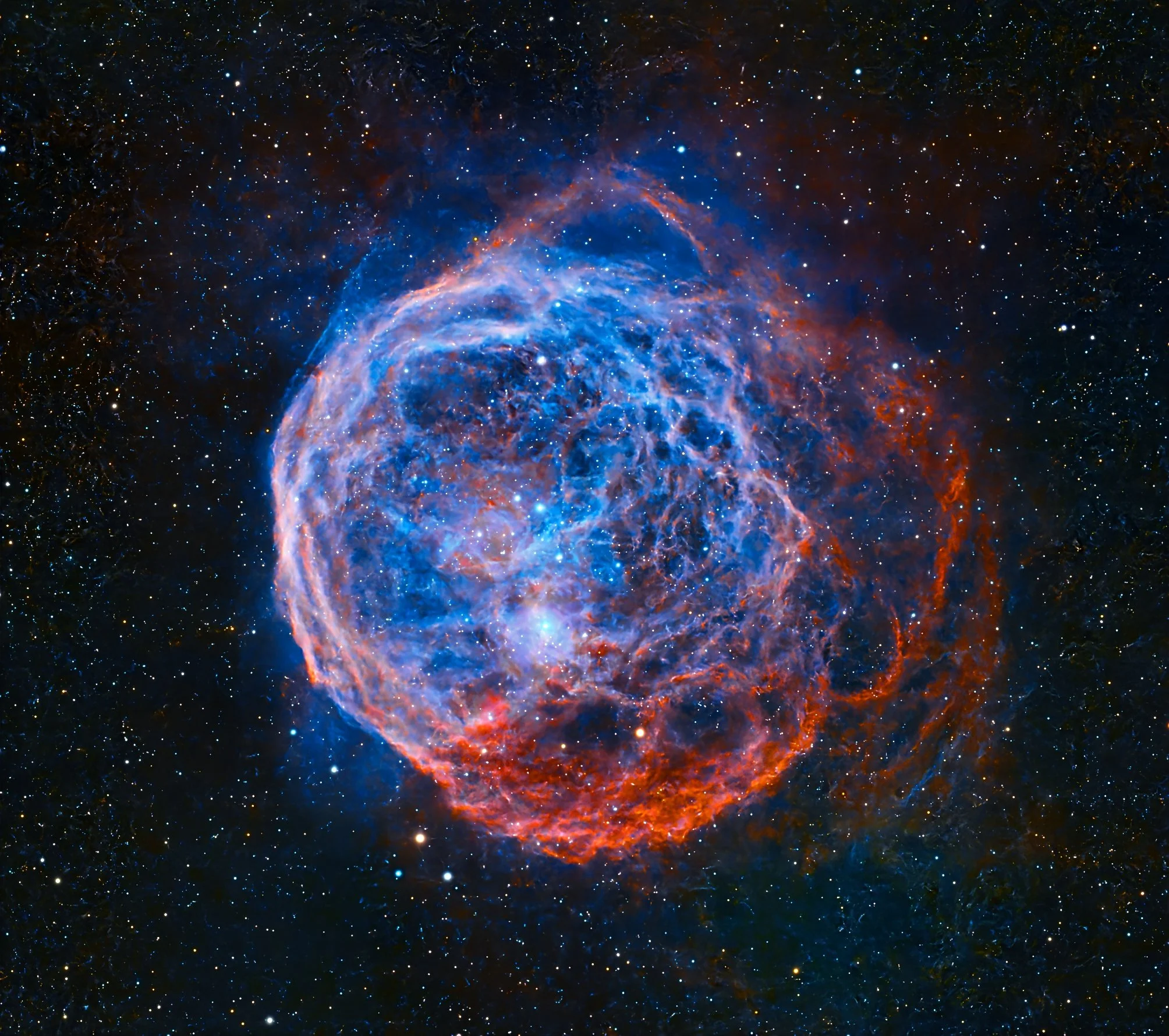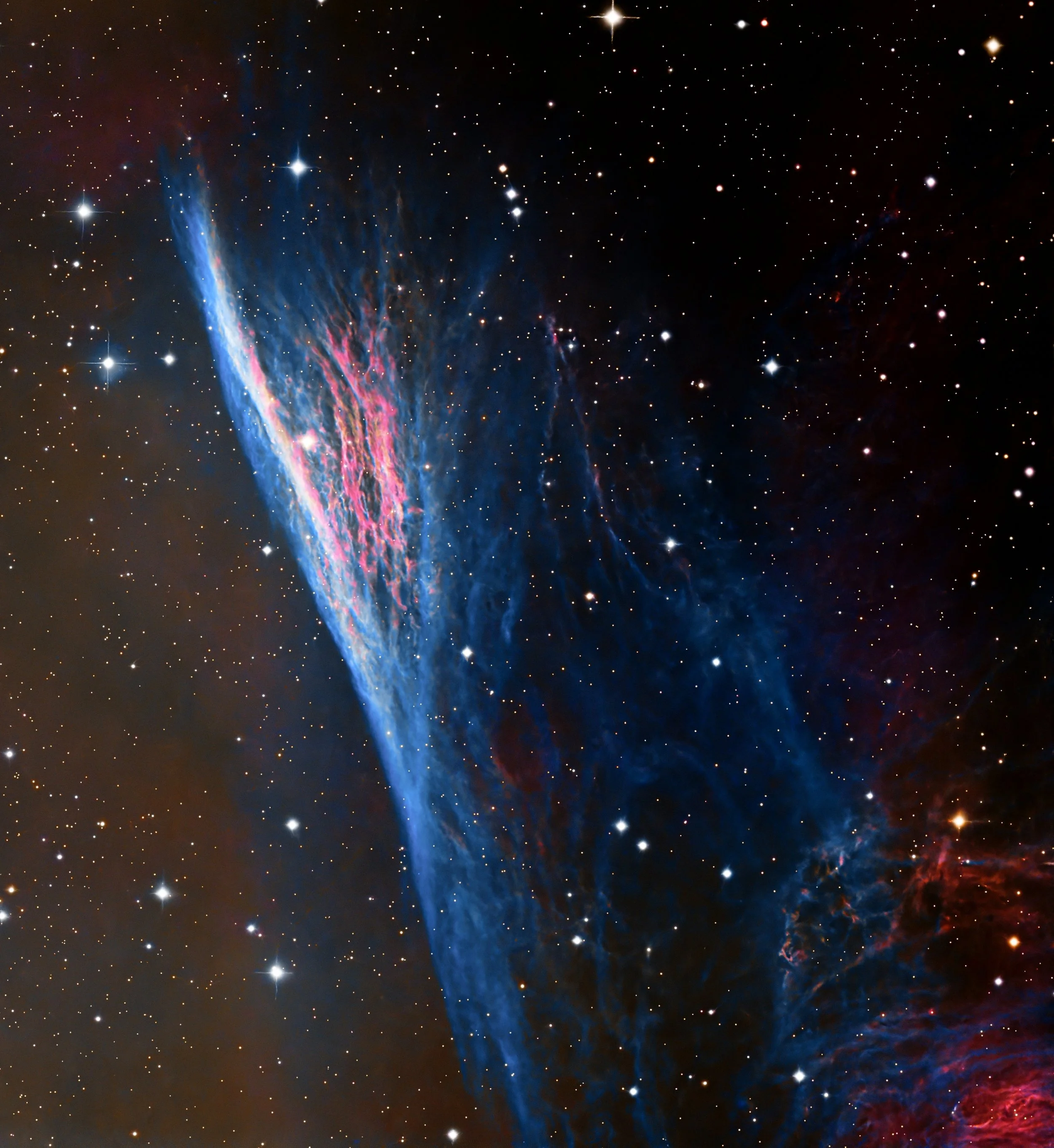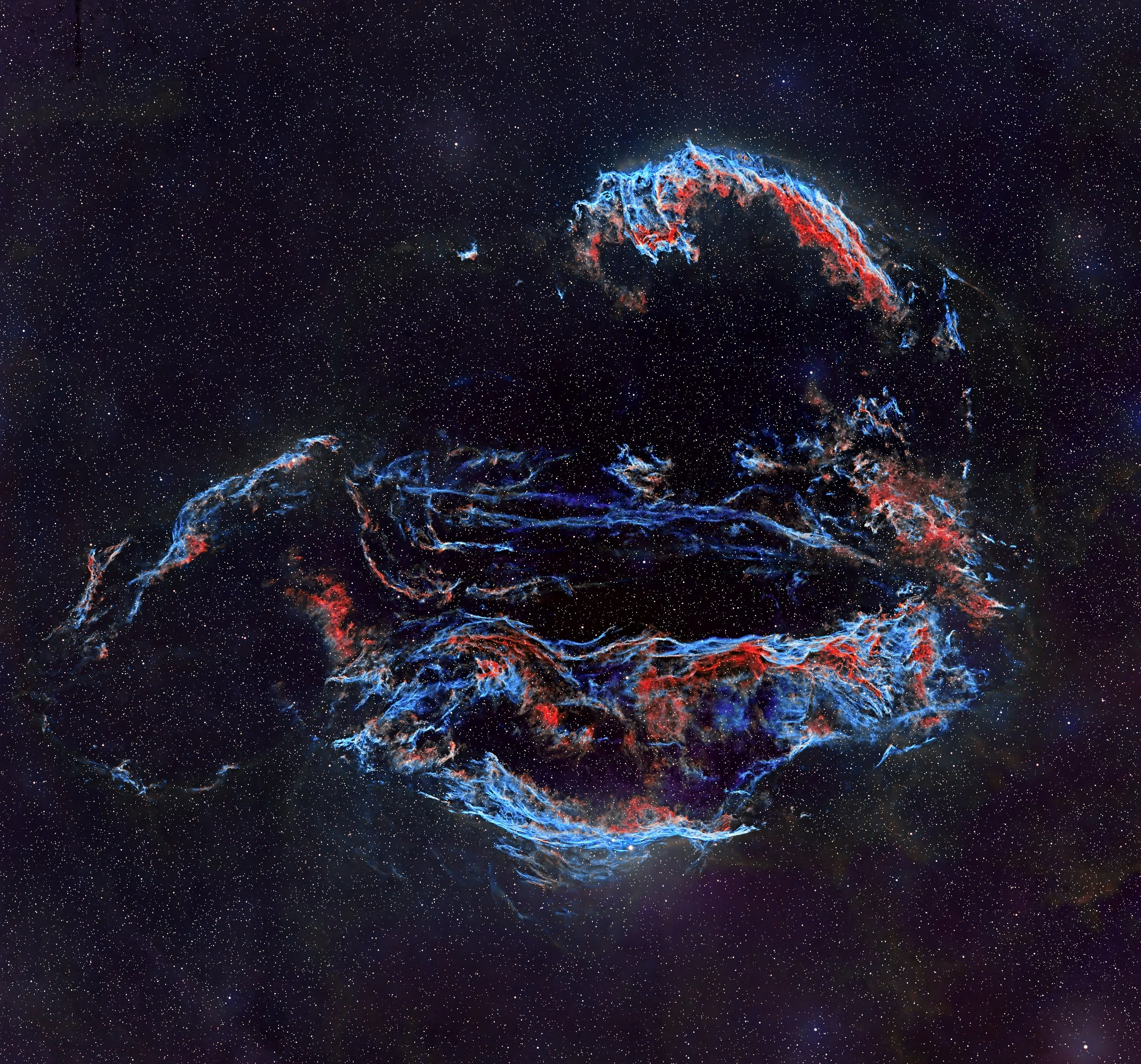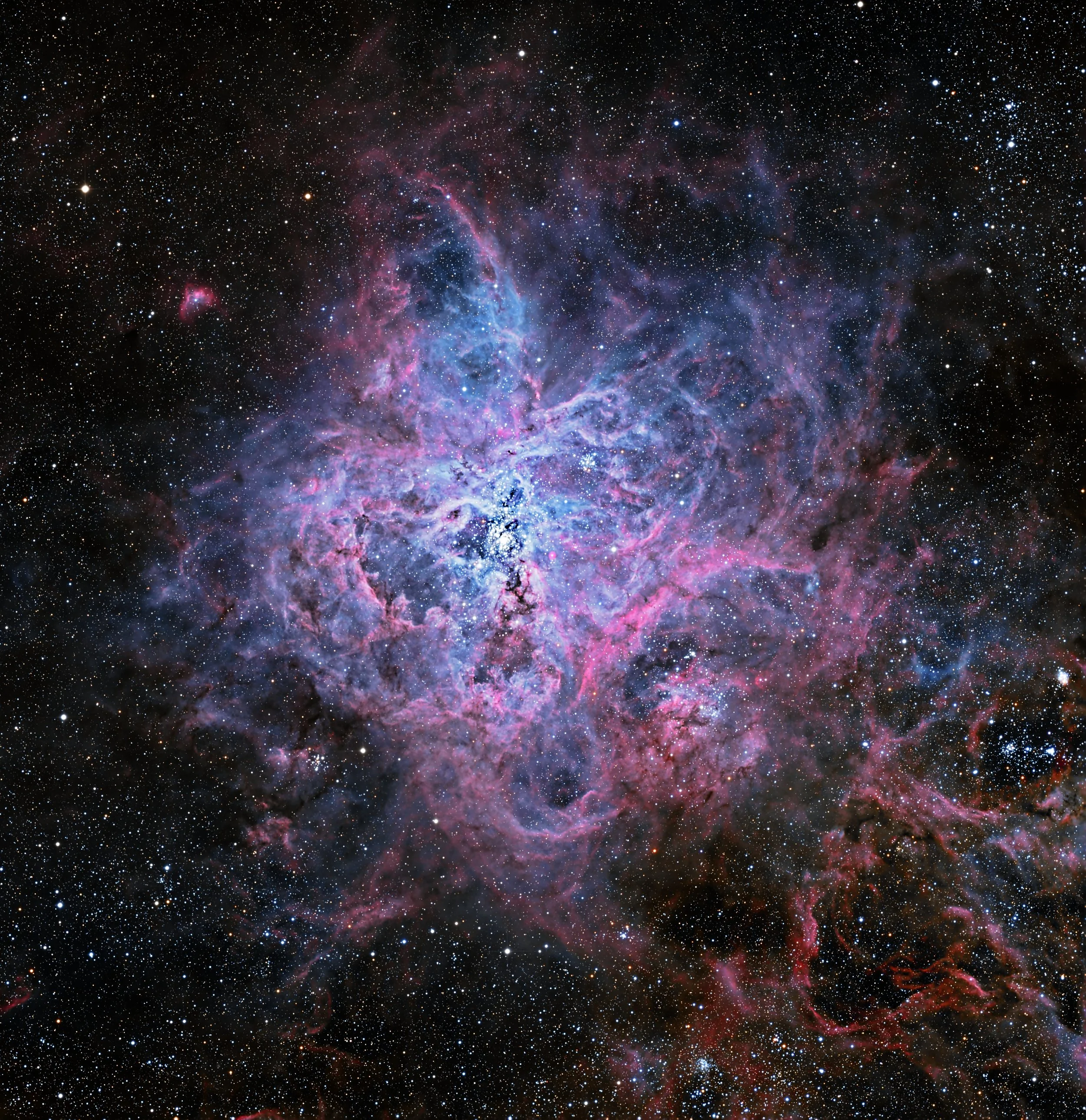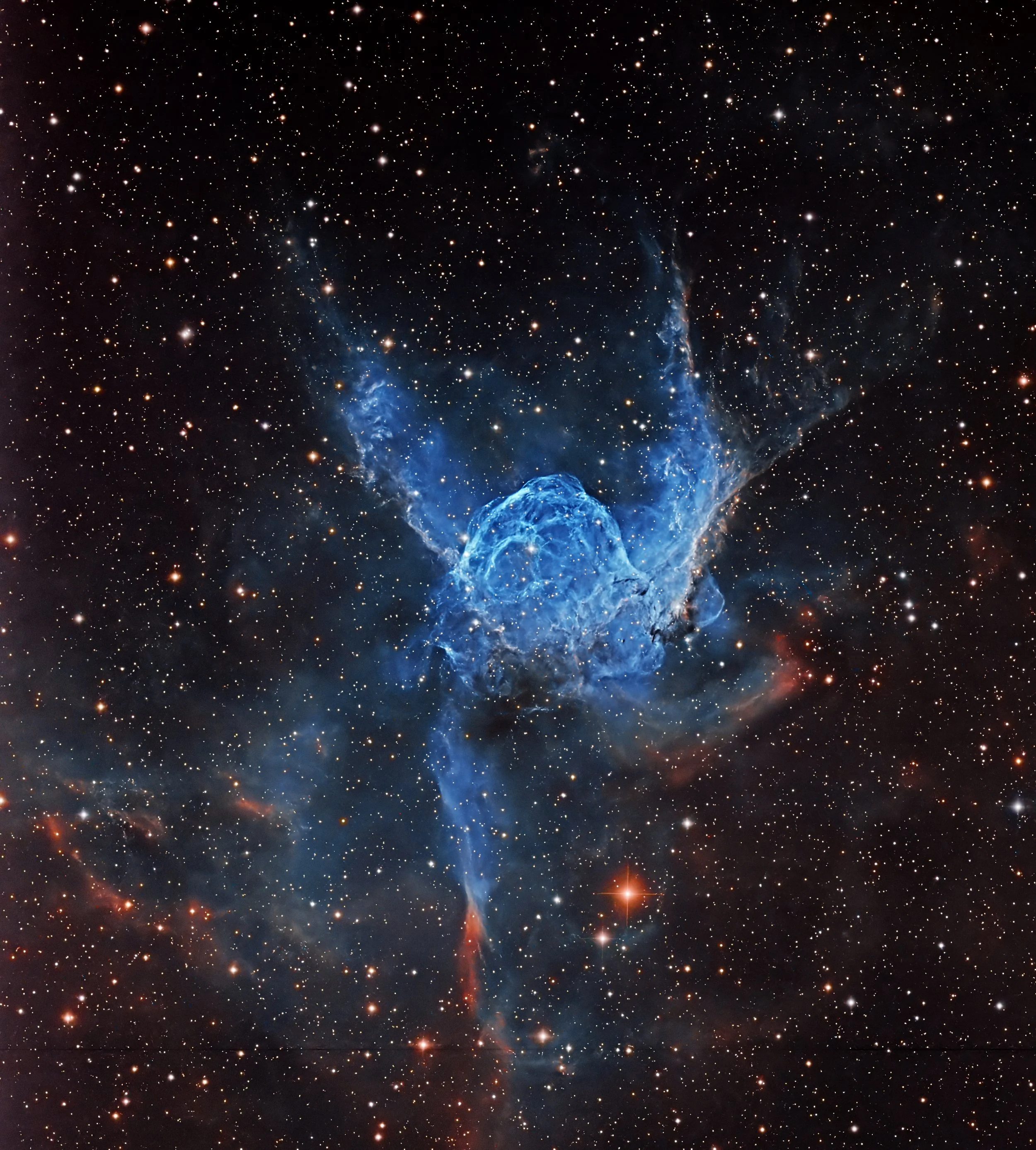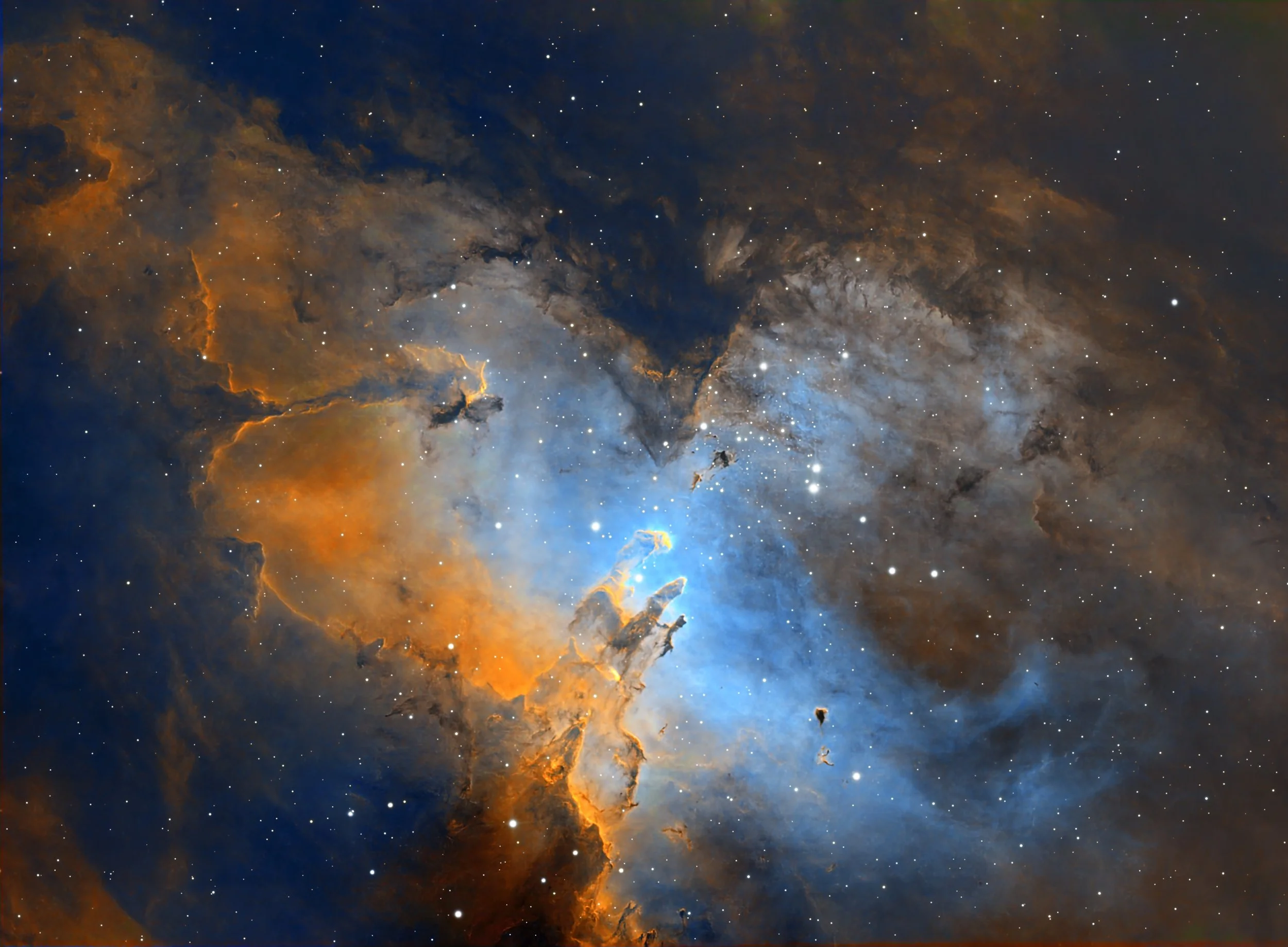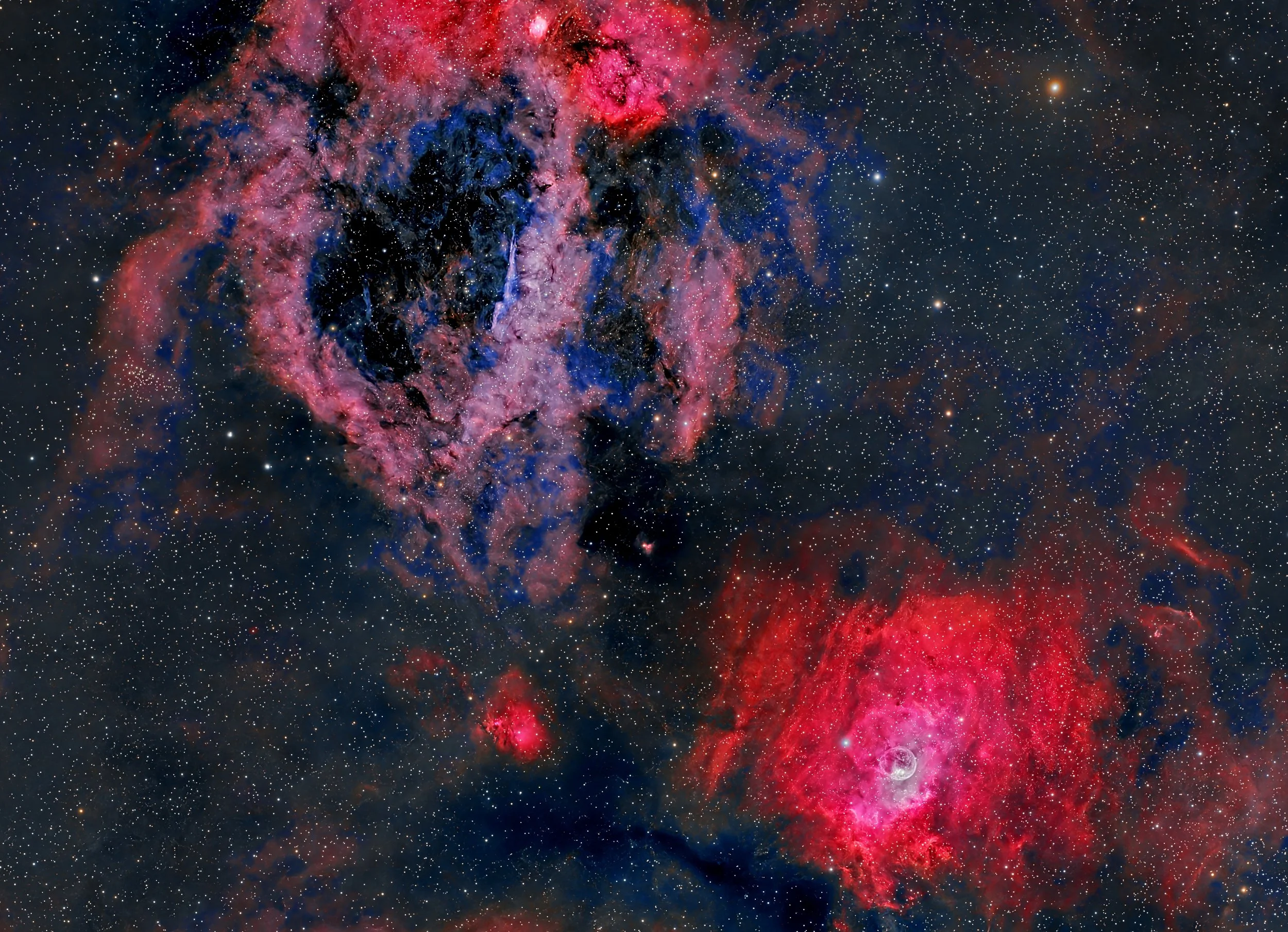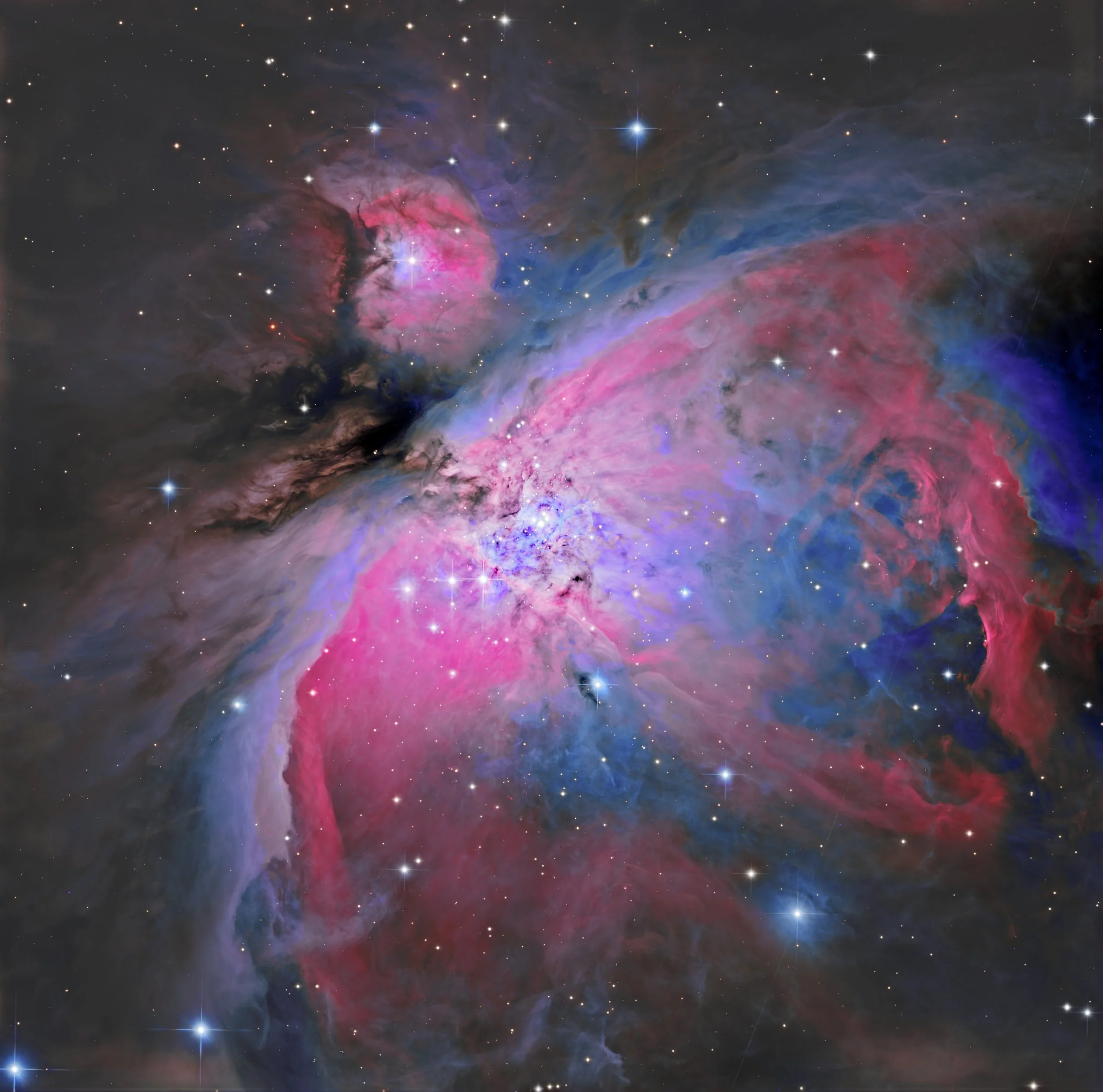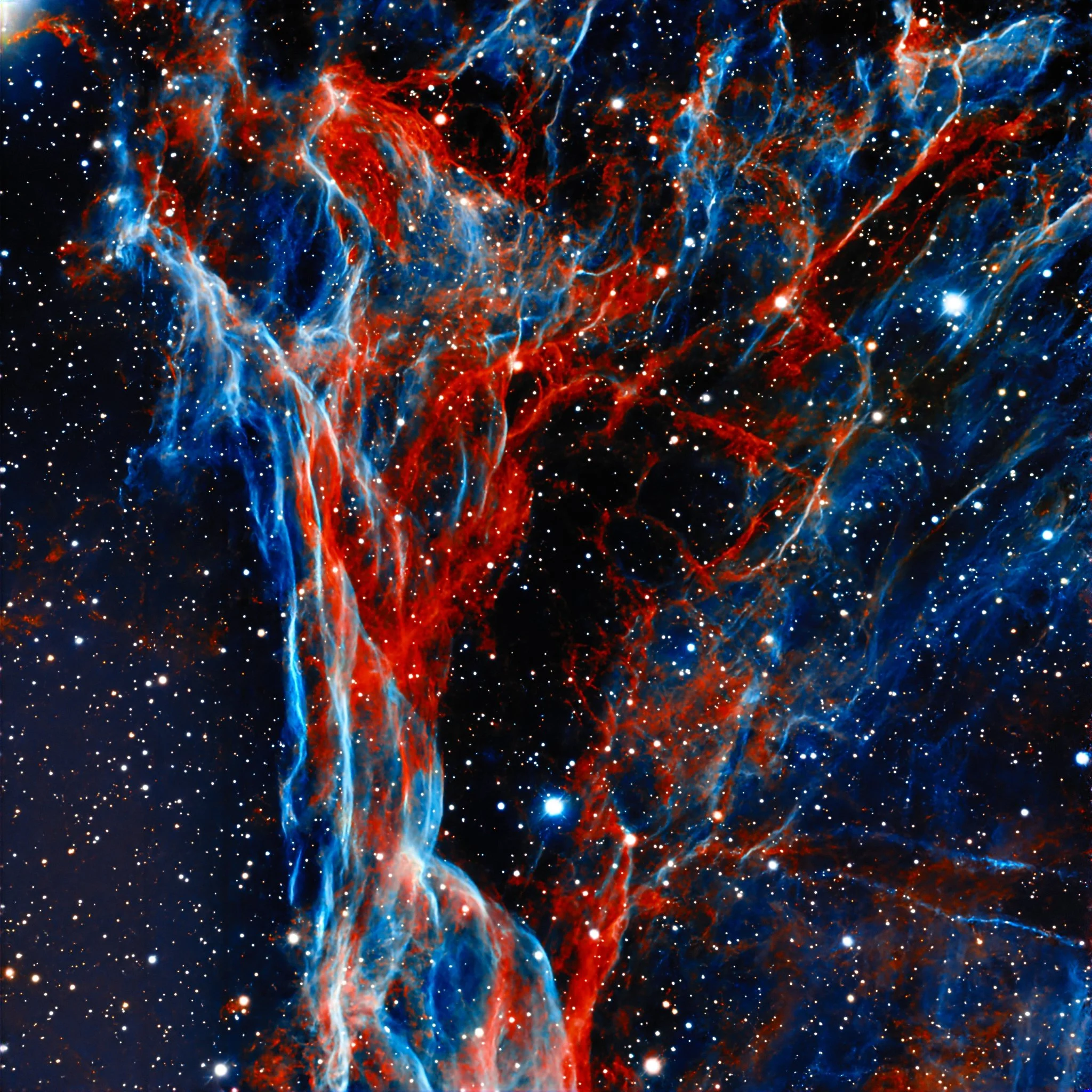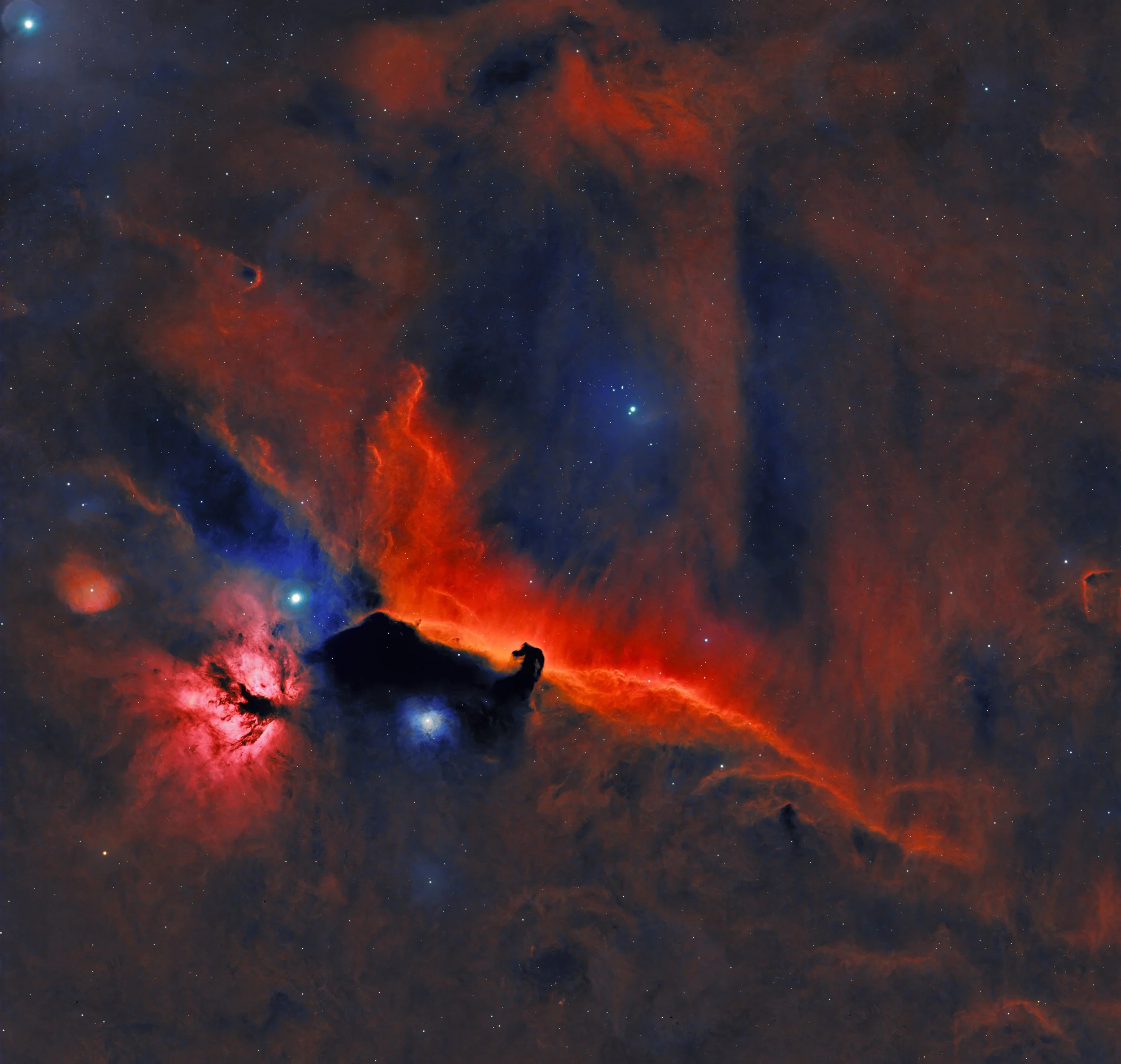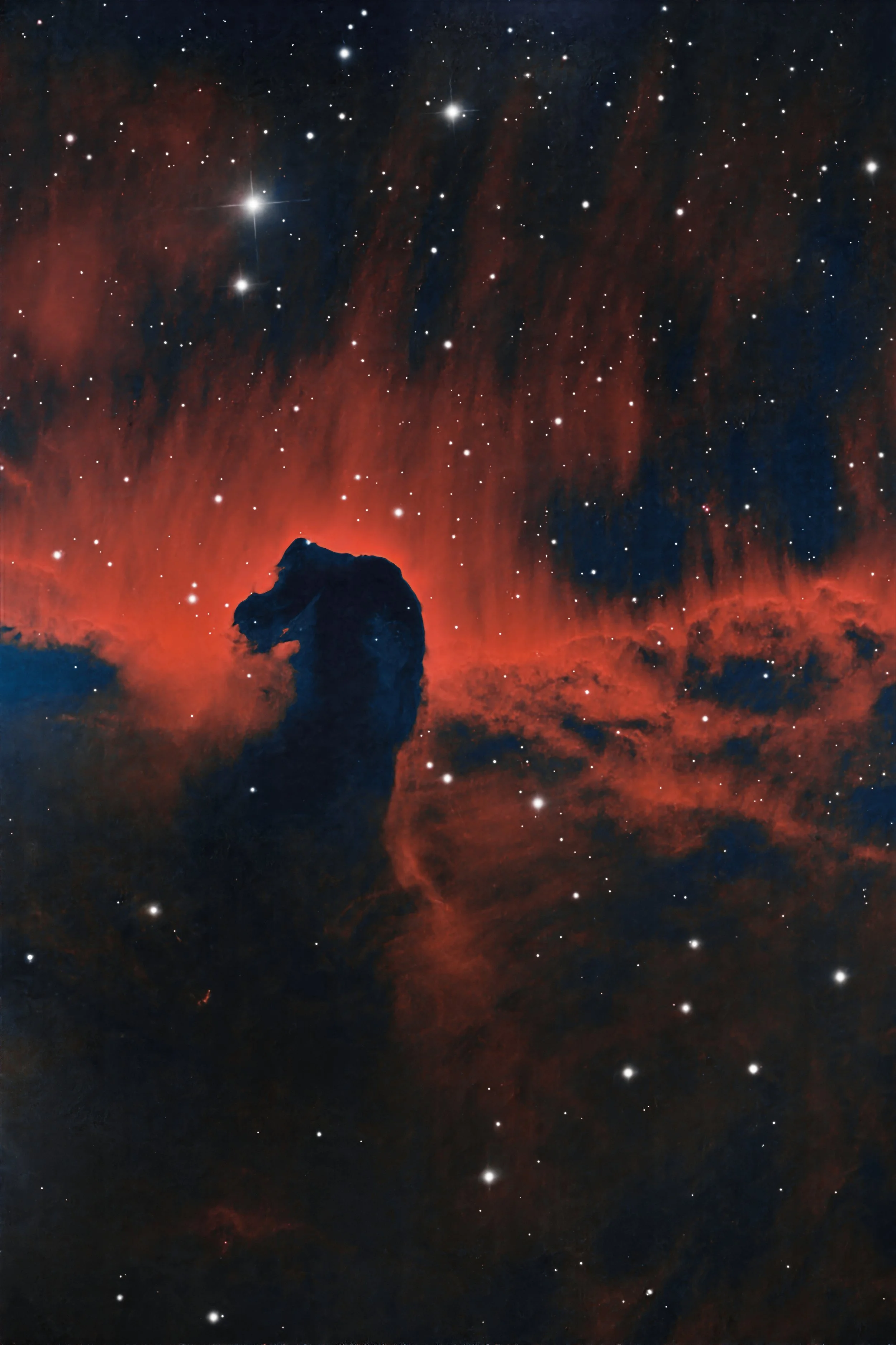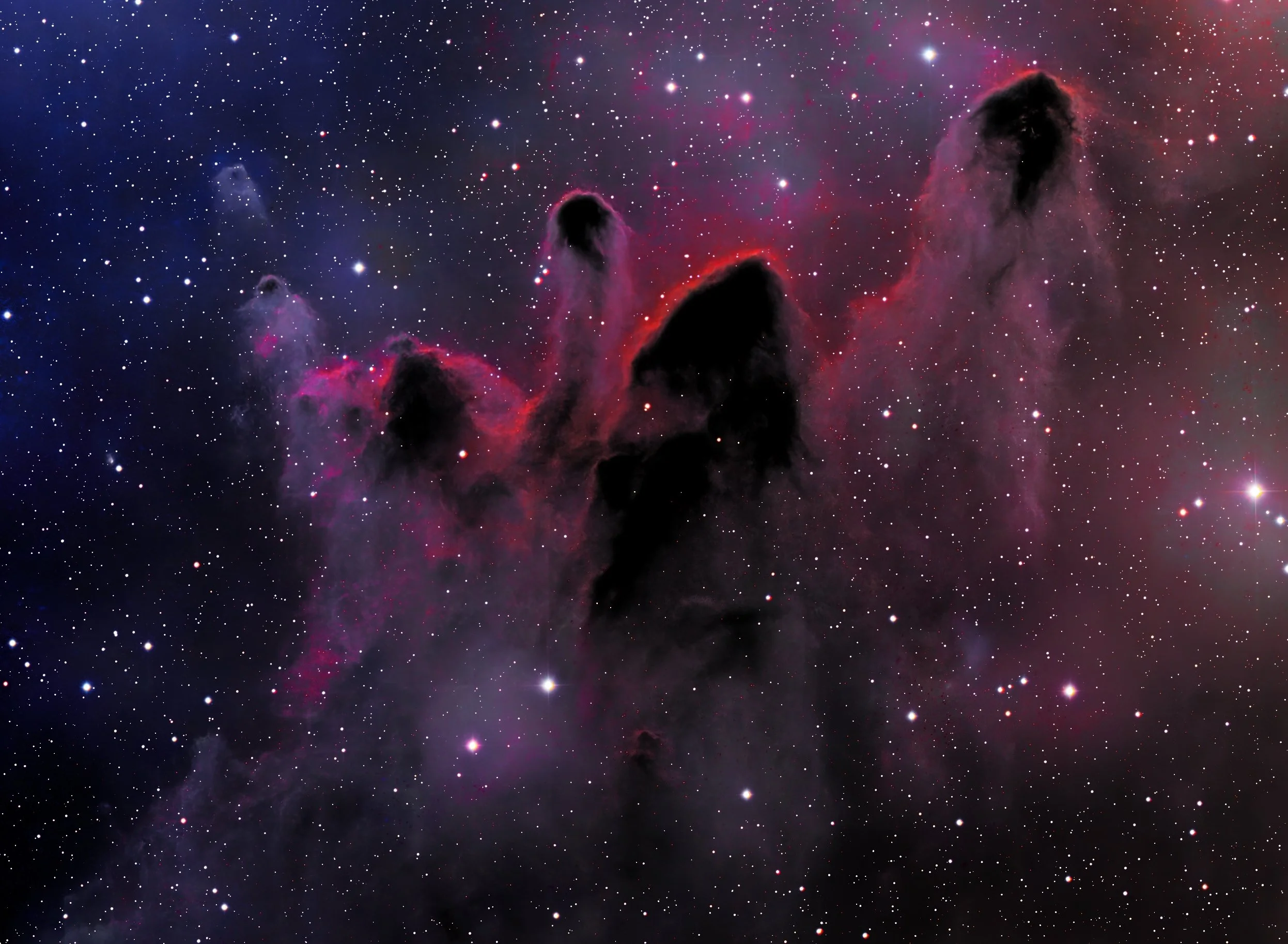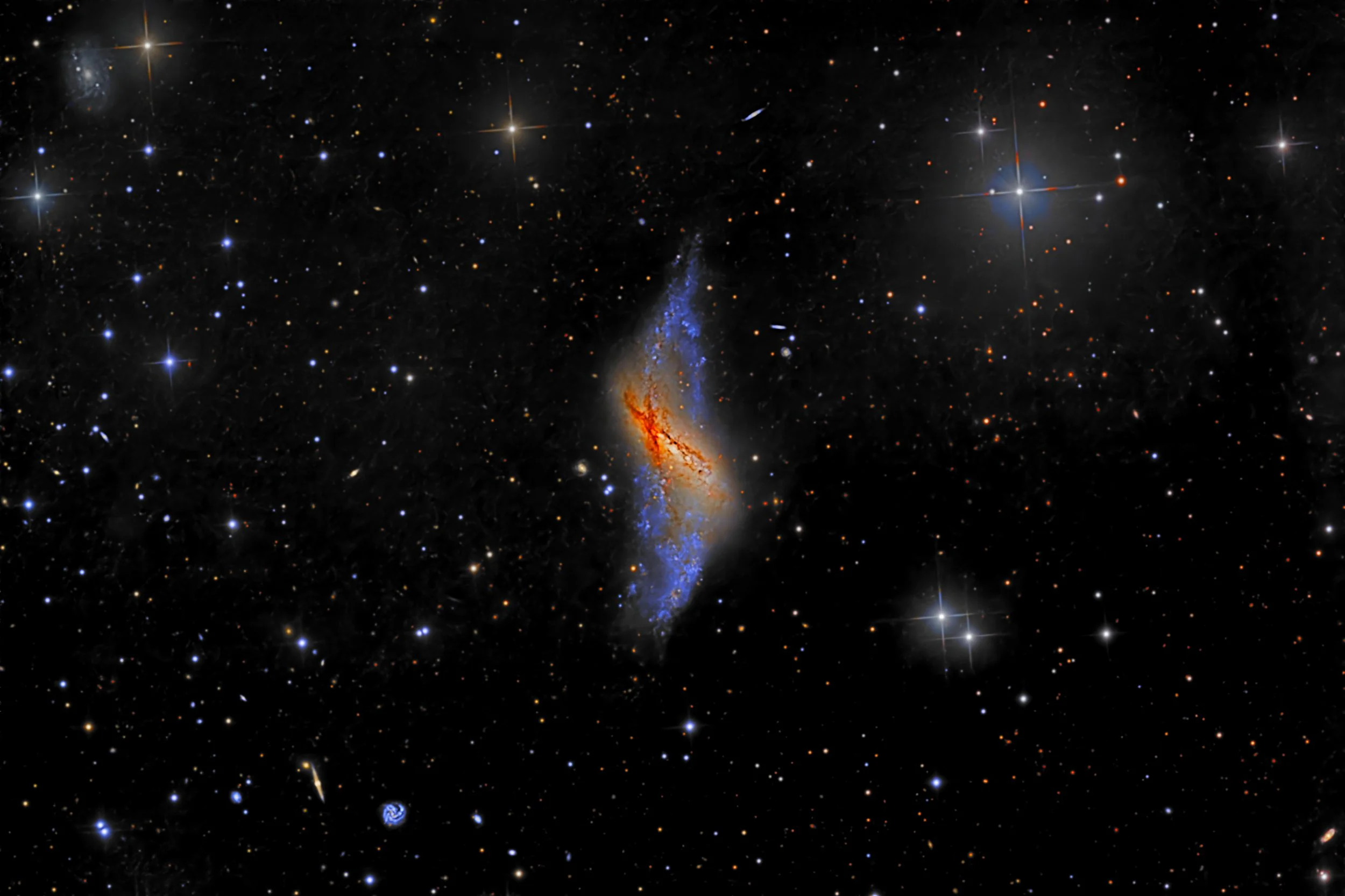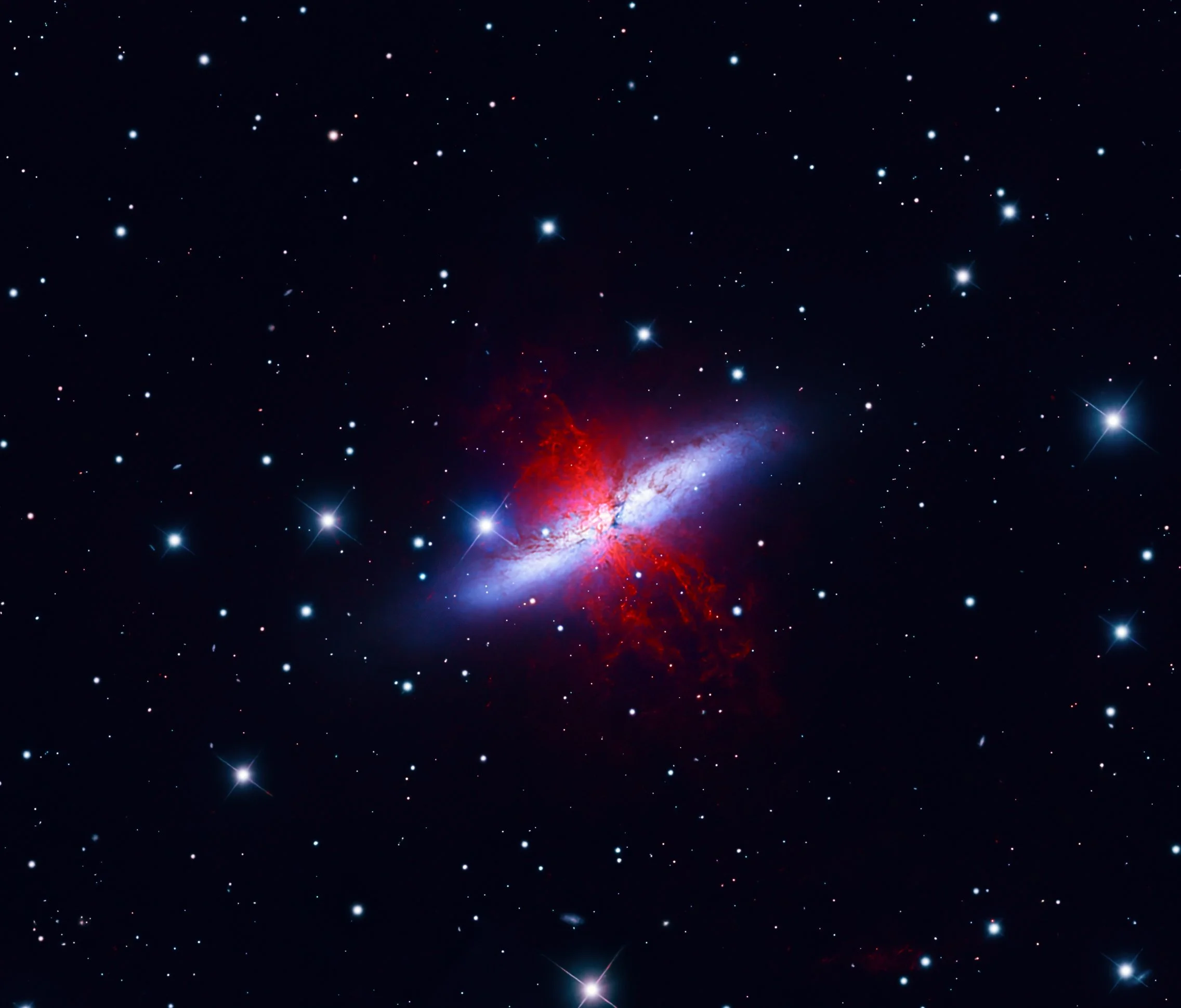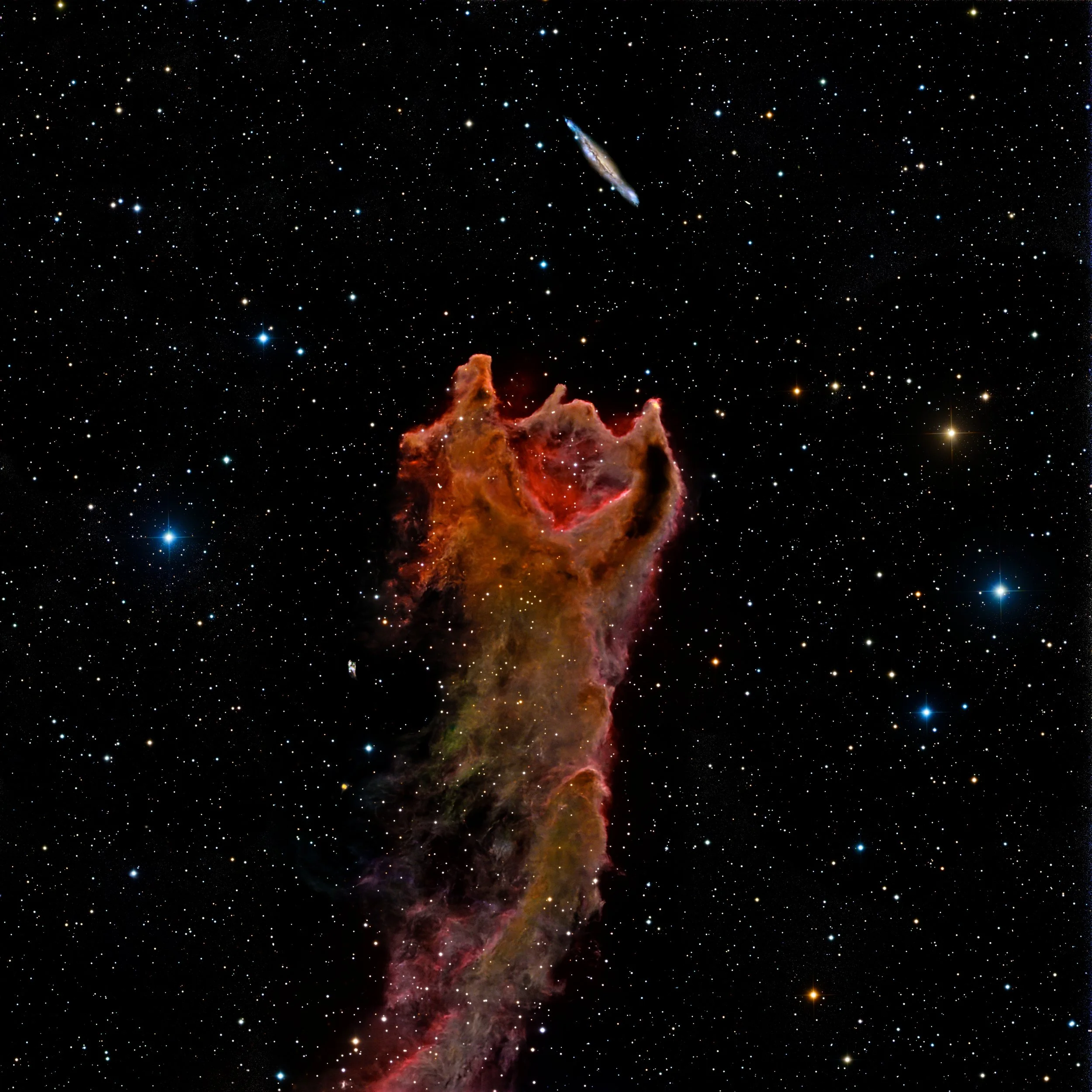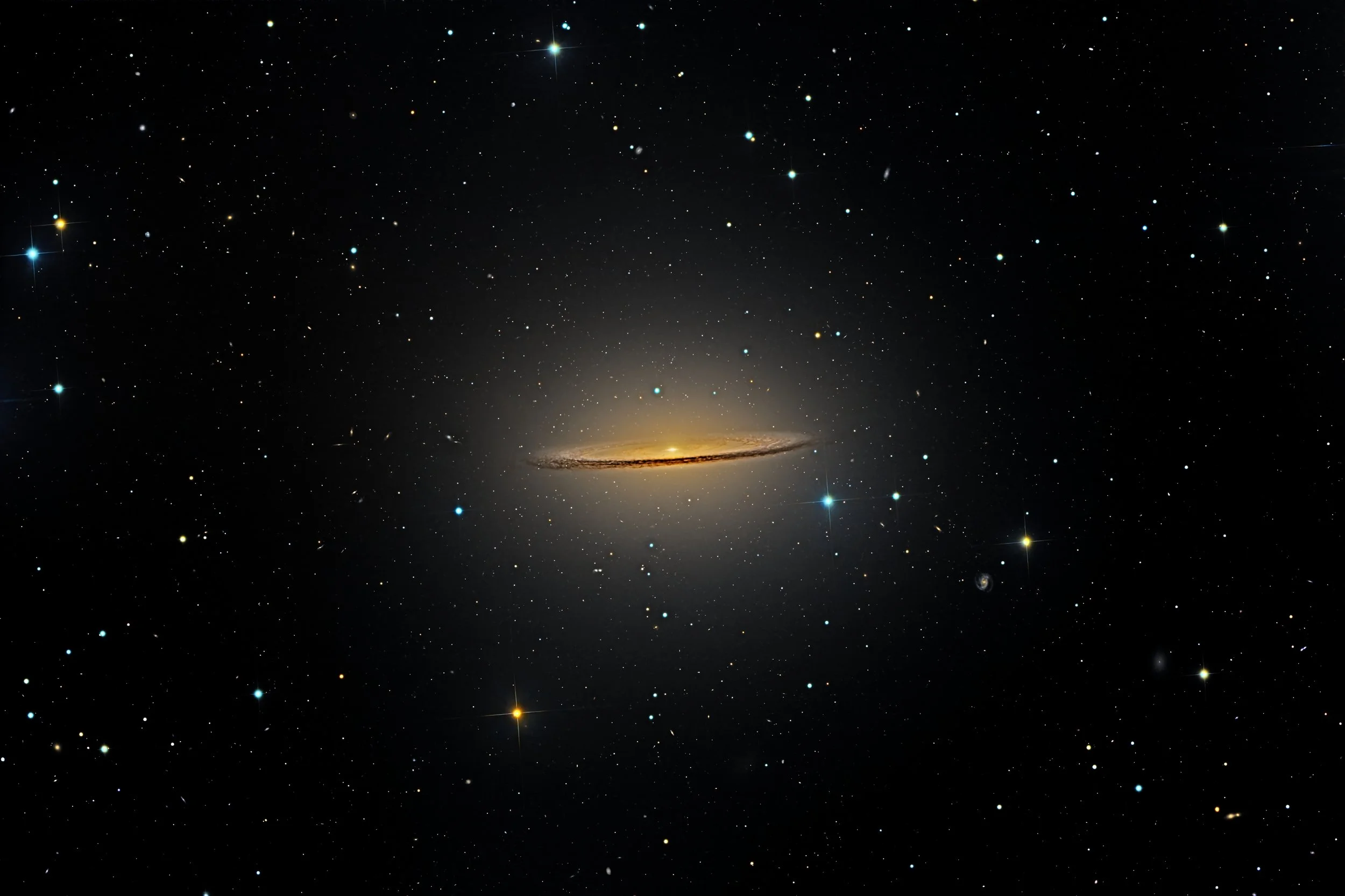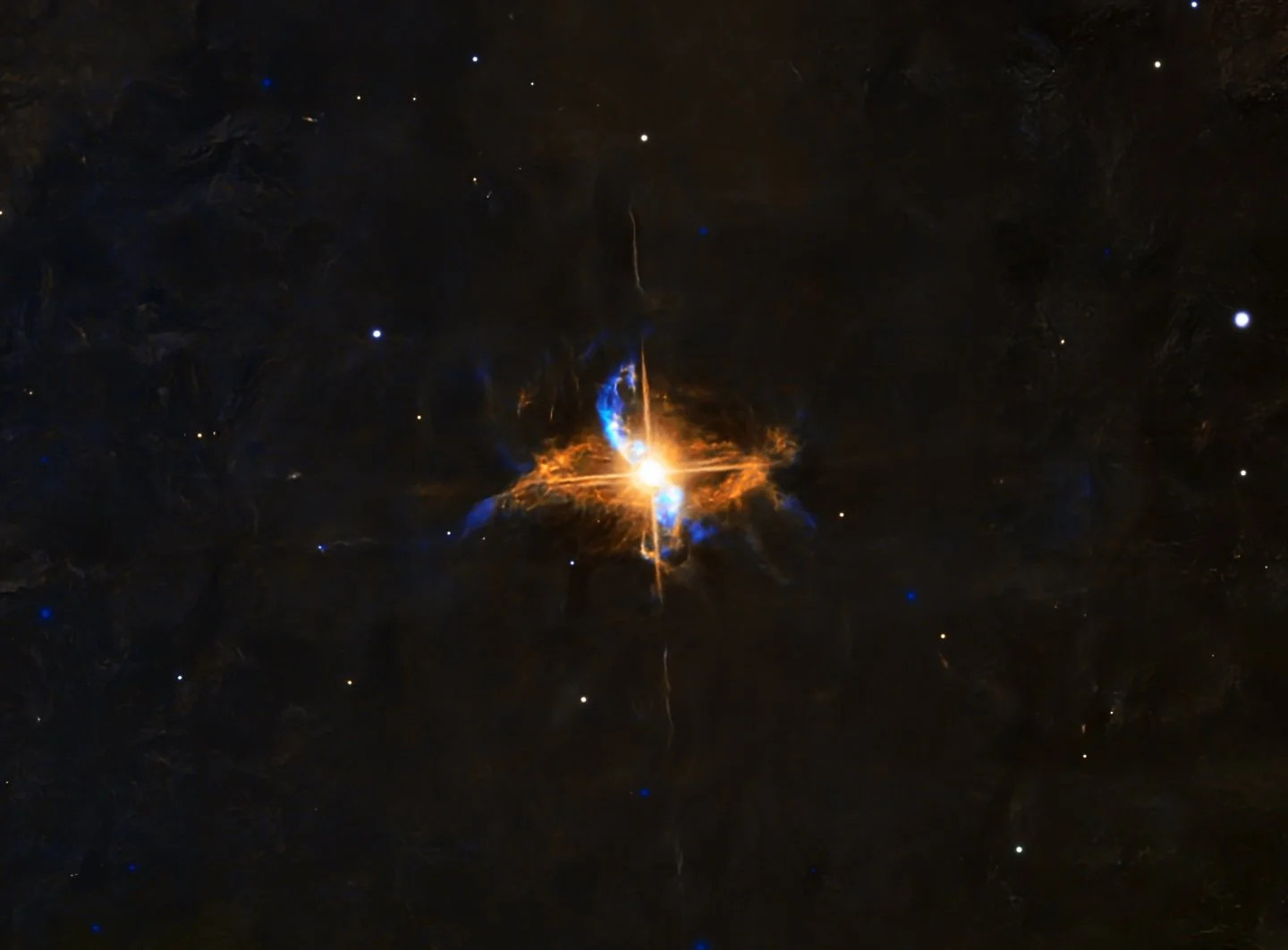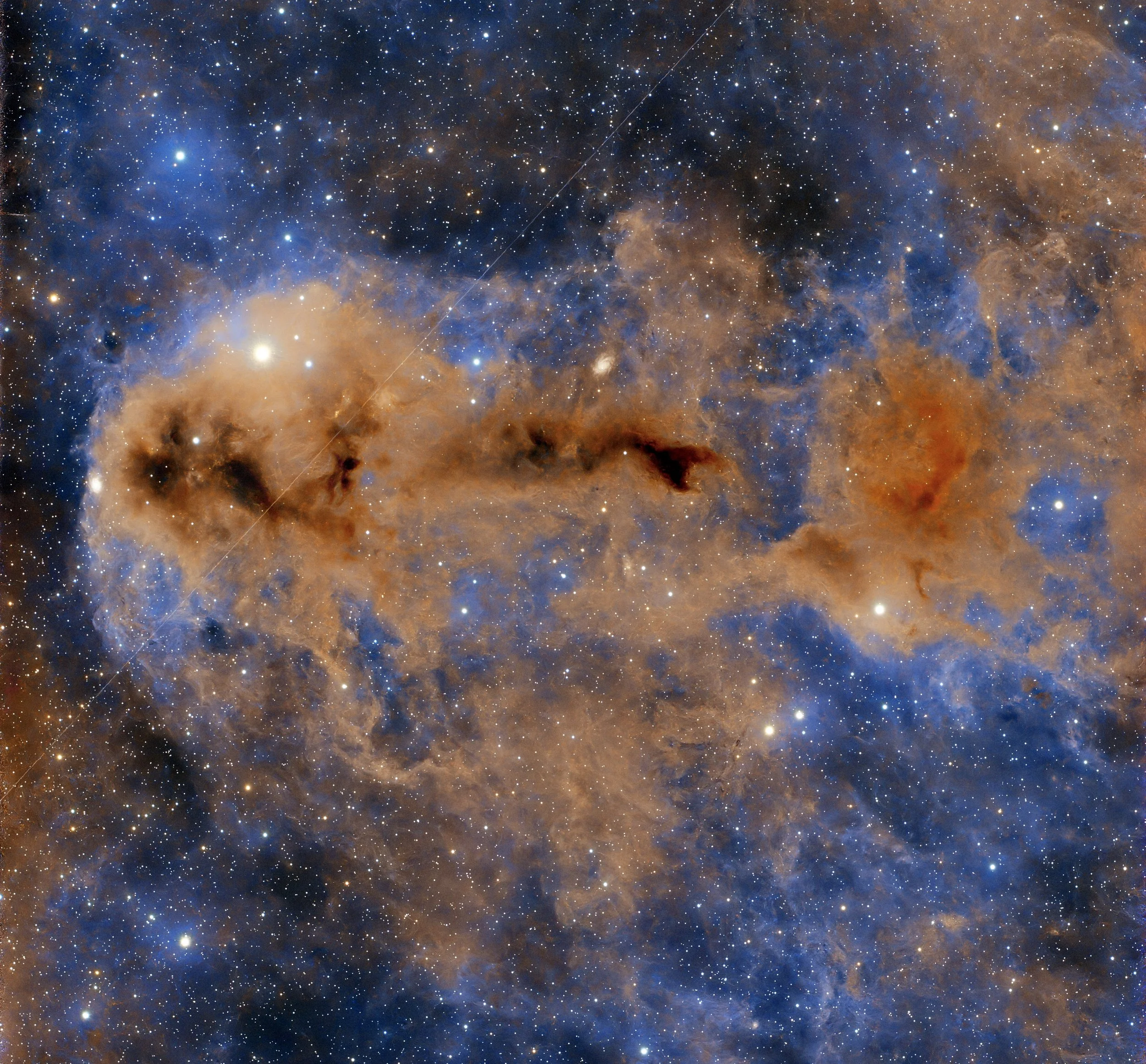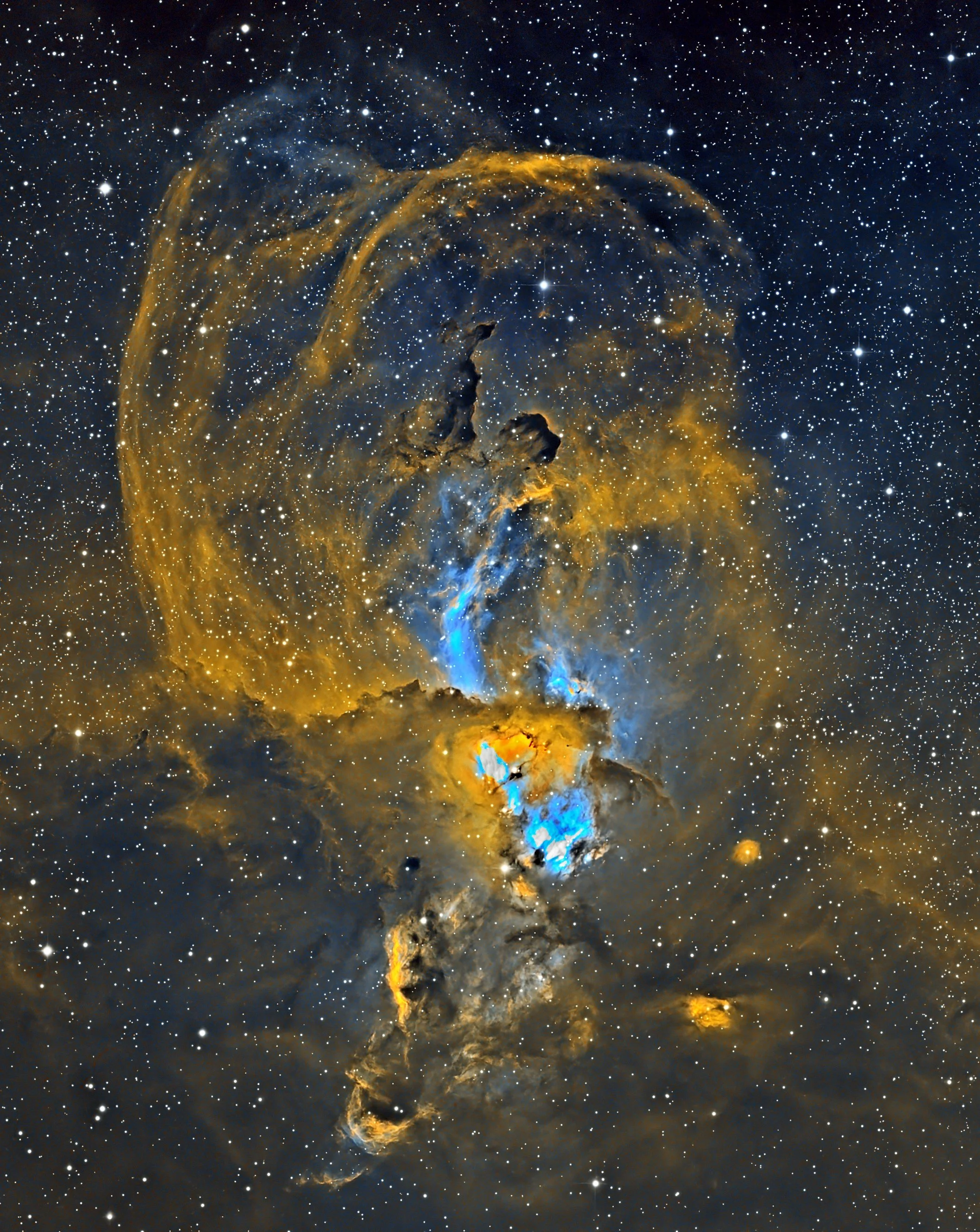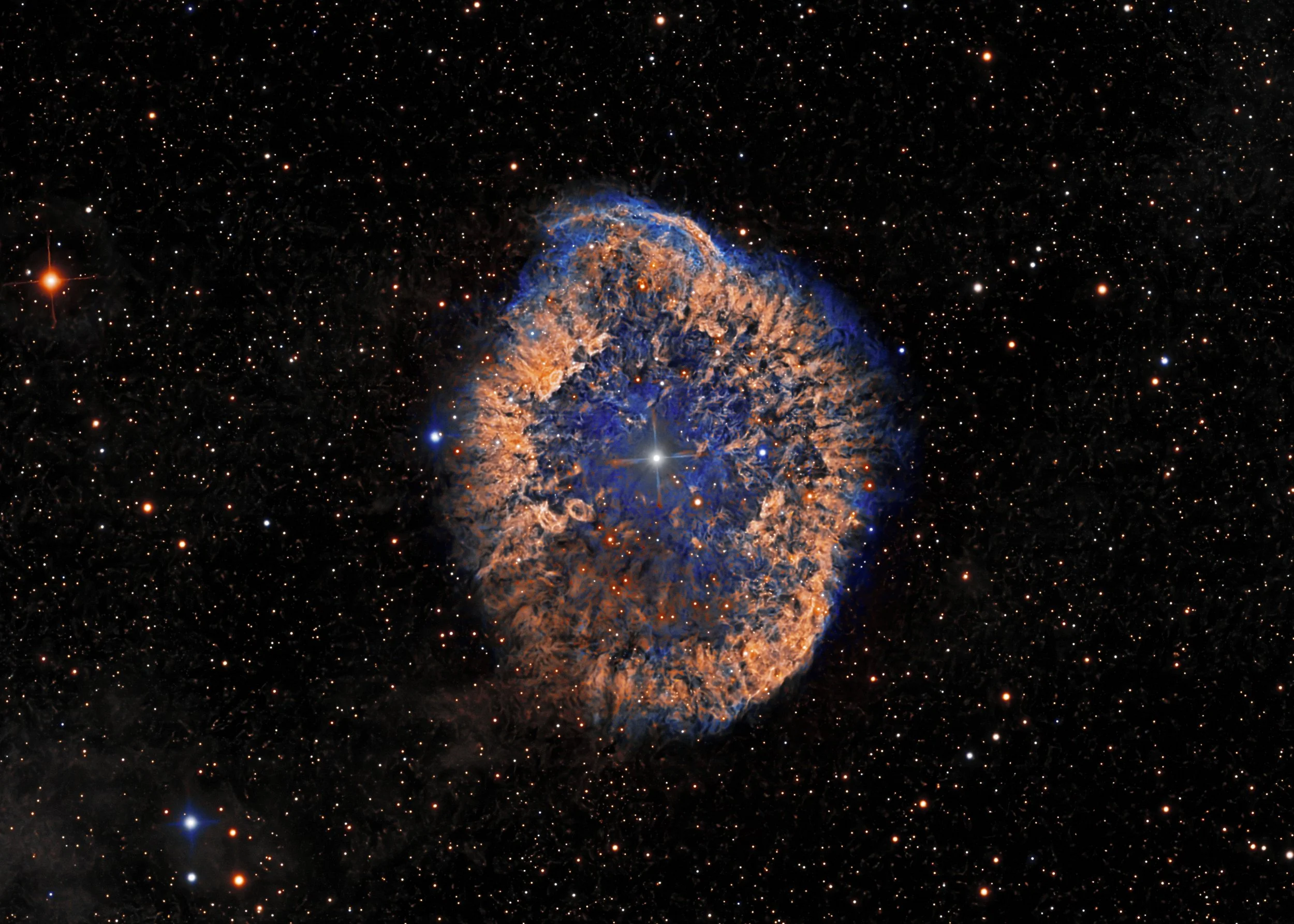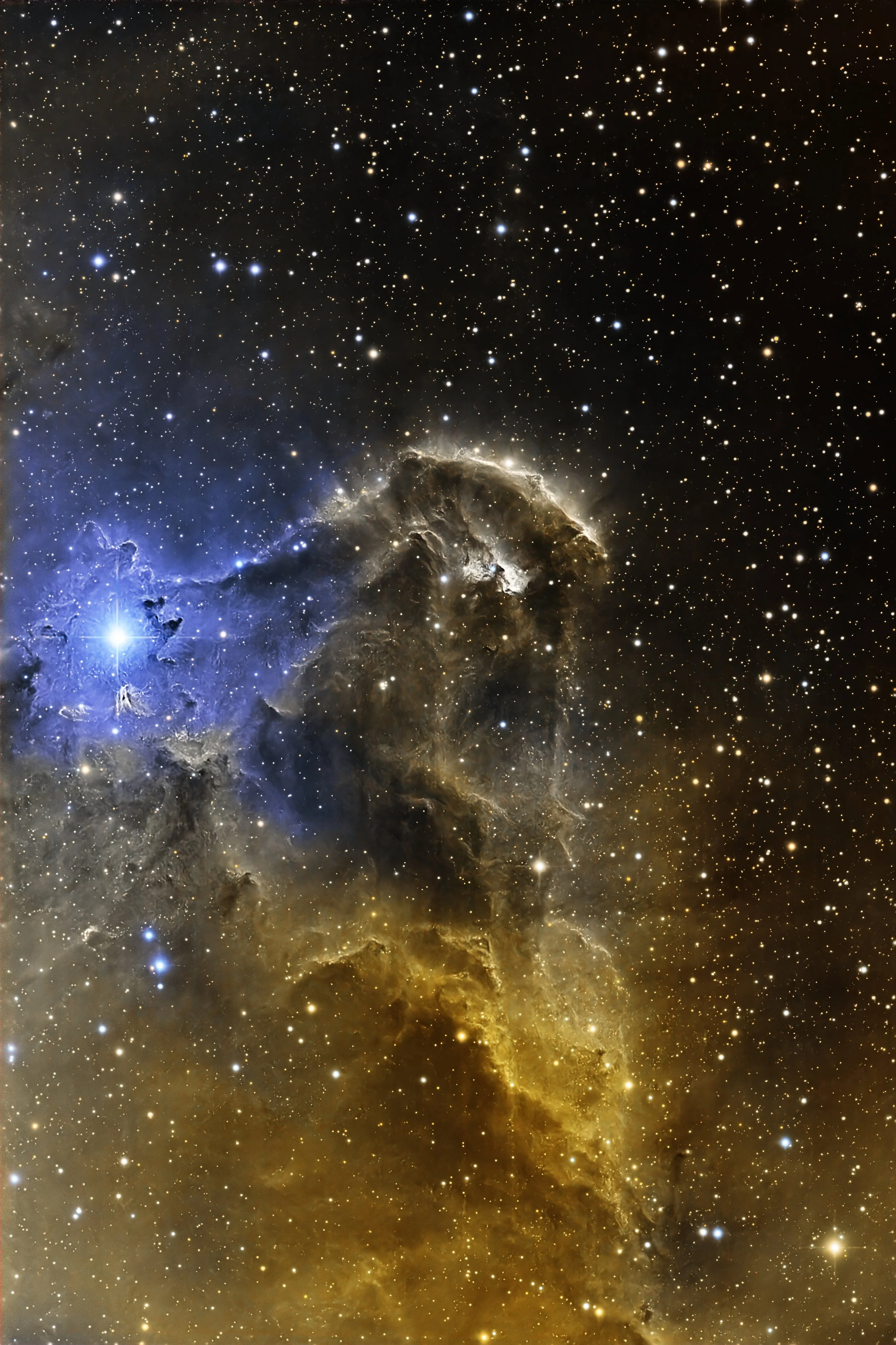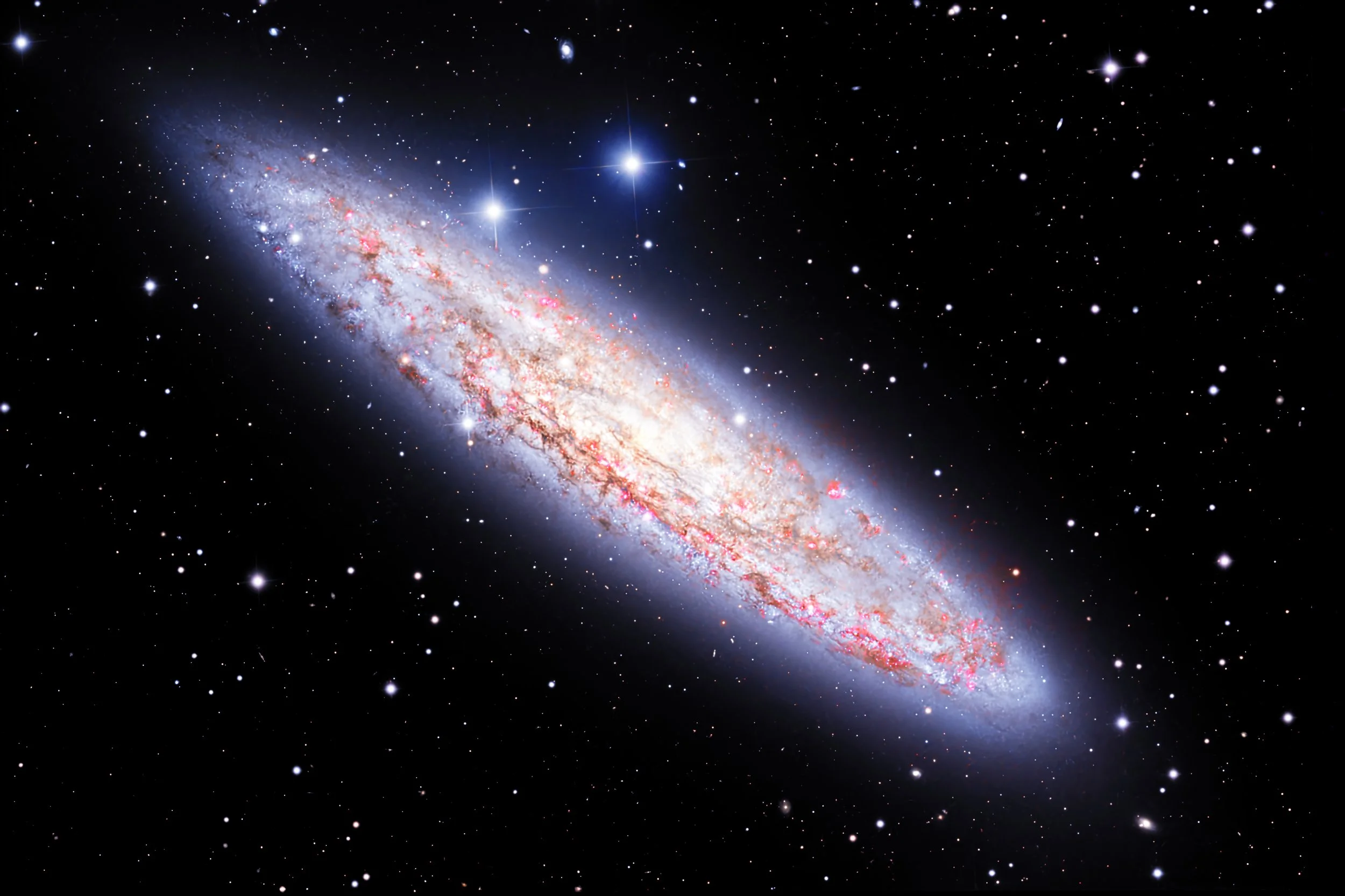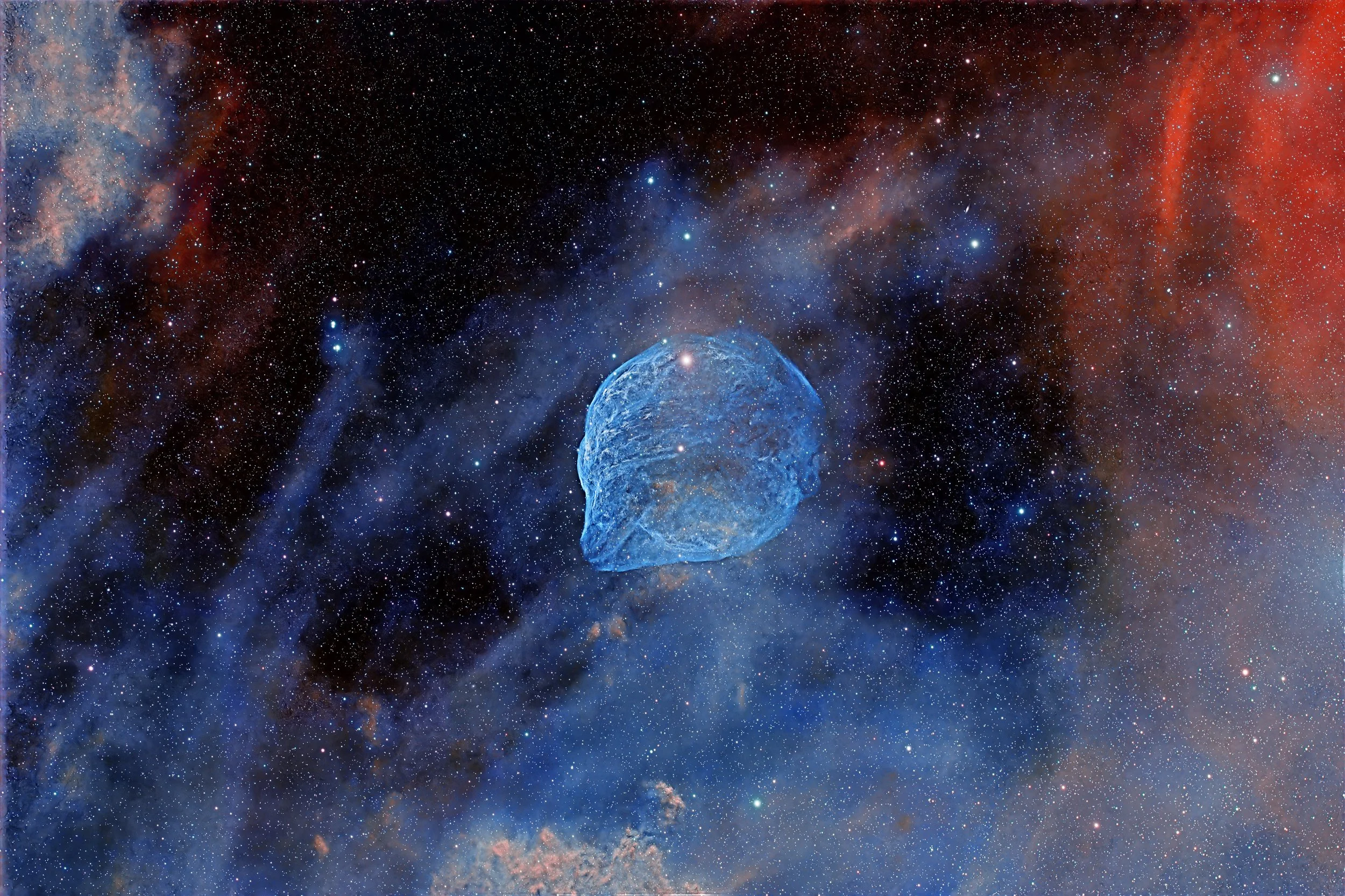The "Dragons of Ara," officially designated NGC 6188, is a star-forming region located approximately 4,000 light-years away. The nebula's distinctive dragon-like shapes are not static. They are carved by intense stellar winds and powerful ultraviolet radiation emitted by the massive, young stars of the embedded Ara OB1 association.
The Rho Ophiuchi cloud complex is one of the closest and most colorful star-forming regions to Earth. Located approximately 460 light-years away, this region is a complex of different types of nebulae, including emission, reflection, and dark nebulae.
NGC 1097 is a prominent barred spiral galaxy located about 45 million light-years away in the southern constellation Fornax. It is known for its spectacular structure, a cannibalistic history, and a feeding supermassive black hole at its center.
The Triangulum Galaxy, a spiral galaxy and the third-largest member of the Local Group of galaxies, after the Andromeda Galaxy and the Milky Way. It is located about 3 million light-years from Earth.
NGC 6543, commonly known as the Cat's Eye Nebula, is one of the most complex and well-studied planetary nebulae in the sky. Located about 3,300 light-years away in the constellation Draco, it represents the end-of-life stage of a star similar to our sun. At the core of the nebula is a very hot, dying star that has shed its outer gaseous layers. This star is on its way to becoming a white dwarf.
The Cigar Galaxy, M82, a starburst galaxy located about 12 million light-years away. It forms new stars ten times faster than the Milky Way. This activity is believed to have been triggered by a gravitational interaction with its larger neighbor, M81.
Messier 31 (M31), more commonly known as the Andromeda Galaxy, is the largest and closest major galaxy to our own Milky Way. Located approximately 2.5 million light-years away in the constellation Andromeda, it is the dominant member of the Local Group of galaxies. Andromeda is a barred spiral galaxy with a diameter of about 220,000 light-years, making it significantly larger than the Milky Way. It contains an estimated one trillion stars—several times the number of stars in our galaxy.
NGC 6744 is a prominent and beautiful intermediate spiral galaxy located approximately 30 million light-years away. Like most large galaxies, NGC 6744 hosts a supermassive black hole at its core. It is classified as a low-luminosity active galactic nucleus (AGN) because its black hole is actively feeding on surrounding material and emitting radiation
RCW 120 is an emission nebula and H II region located about 4,300 light-years away. It appears as a glowing ring or bubble of ionized gas, about 10 light-years across. The bubble is blown by intense ultraviolet light and stellar winds from a central, massive O-type star, designated CD -38 11636. These forces carve out the bubble from the surrounding molecular cloud. The nebula hosts an unusually large embryonic star, already about 10 times the mass of the Sun, is surrounded by a massive cloud of gas and dust from which it continues to accrete material.
Vela XYZ is the radio designation for the Vela Supernova Remnant, the expanding cloud of gas and dust from a massive star that exploded approximately 11,000 to 12,300 years ago. Vela X: A pulsar-wind nebula (or plerion) at the center of the remnant, energized by the powerful Vela Pulsar. Vela Y and Vela Z: Shell-type remnants that are part of the larger, expanding bubble of gas and dust.
NGC 6164, also known as the Dragon's Egg Nebula, is a distinctive emission nebula located approximately 3,870 to 4,200 light-years away. At the heart of NGC 6164 lies the luminous and magnetic star HD 148937. This is a rare O-type star with a mass about 40 times that of the Sun. Recent studies indicate the star is a result of a dramatic stellar merger. It's believed that what was once a triple-star system became unstable, and two of the stars collided and merged. This violent event created the larger, highly magnetic star and expelled the surrounding gas that now forms the nebula.
NGC 2024, commonly known as the Flame Nebula, is an emission nebula and active star-forming region. It is located approximately 1,350 to 1,500 light-years away and is part of the larger Orion Molecular Cloud Complex. The nebula is energized by the brilliant, hot star Alnitak (Zeta Orionis), the easternmost star in Orion's Belt. While Alnitak is visually close to the nebula, it is a foreground star and not physically within the nebula itself. Its intense ultraviolet radiation strips electrons from the hydrogen gas in the nebula, causing it to glow brightly as the electrons and hydrogen recombine.
LDN 1217, the Wolf's Cave Nebula, is a dense molecular cloud, a type of stellar nursery where new stars can eventually form from its gas and dust. It is also classified as a Bok globule.
NGC 2736, commonly known as the Pencil Nebula, is a long, thin, bright nebula in the southern constellation of Vela. It is a relatively small and highly visible part of the much larger Vela Supernova Remnant. It was created by the shock wave from a massive star that exploded approximately 11,000 to 12,300 years ago. This shock wave is still expanding outward into space, encountering regions of dense interstellar gas and dust.
IC 5070, also known as the Pelican Nebula. The nebula's distinctive shape, resembling a pelican's head and neck, is sculpted by powerful ultraviolet radiation and stellar winds. Radiation, coming from the hot, young stars forming within and behind the nebula, creates an ionization front. This front is the boundary where the intense radiation is slowly transforming the cold gas into hot, ionized gas, causing it to glow brightly.
NGC 2070 is the central, massive star cluster at the heart of the Tarantula Nebula (also known as 30 Doradus). Located approximately 170,000 light-years away in the Large Magellanic Cloud (LMC), it is one of the most energetic star clusters known. Its intense stellar radiation is what causes the gas and dust of the Tarantula Nebula to glow so brightly.
NGC 2359, popularly known as Thor's Helmet, is a striking emission nebula located about 12,000 light-years away. At the heart of NGC 2359 is a massive Wolf-Rayet star known as WR 7. WR 7 is thought to be in a brief, pre-supernova stage of evolution, and is expected to end its life in a spectacular supernova explosion within a few thousand years.
M16 is the designation for the Eagle Nebula, a young open cluster of stars and an active star-forming region. The nebula is most famous for a stunning feature known as the Pillars of Creation, a stellar nursery where new stars are being born inside dense gaseous globules called Evaporating Gaseous Globules.
M42 is the Messier designation for the Orion Nebula, one of the brightest and most famous nebulae in the night sky. It is a diffuse nebula and massive stellar nursery located in the constellation Orion, just below the three stars of Orion's Belt. At the heart of the nebula is a very young, tight cluster of hot, massive stars known as the Trapezium Cluster. The intense ultraviolet radiation from these stars is what causes the surrounding gas to glow brightly, sculpting the nebula's iconic shape.
Pickering's Trianglea prominent part of the Veil Nebula. It, along with the entire Veil Nebula, is the remnant of a massive star that exploded as a supernova between 10,000 and 20,000 years ago. The shockwaves from the explosion are still expanding into space, heating and ionizing the surrounding interstellar gas and dust.
The Horsehead Nebula, B33, is a dark, cold, and dense cloud of gas and dust that blocks light from the emission nebula, IC 434, behind it. This creates the silhouette of a horse's head that makes the nebula so distinct. The background emission nebula glows a faint pinkish color due to radiation from the nearby hot star Sigma Orionis. The nebula's distinct shape is constantly being sculpted by the intense stellar winds and radiation from nearby stars. Astronomers estimate that in about five million years, the Horsehead formation will likely disintegrate due to this erosion.
Close-up of B33, the Horsehead Nebula
CG 30 and CG 31 are a group of cometary globules, which are isolated, compact clouds of gas and dust with a distinctive comet-like shape. They are located within the Gum Nebula, a large, expanding cloud of ionized hydrogen.
NGC 660 is a rare polar-ring galaxy located approximately 45 million light-years away. This type of galaxy is characterized by a ring of stars, gas, and dust orbiting almost perpendicular to the main galactic disk. he galaxy has a prominent tilted ring stretching over 50,000 light-years, containing bright blue and red supergiant stars and active star-forming regions.
CG 4, often referred to as "God's Hand" or the "Mouth of the Beast," is a prominent cometary globule located approximately 1,300 light-years away.
M104, also known as the Sombrero Galaxy, is an unbarred spiral galaxy. At its center lies one of the most massive black holes ever found in a nearby galaxy, weighing approximately one billion times the mass of our Sun.
R Aquarii is a symbiotic variable star systems, located approximately 700 light-years away. This unique binary system consists of a pulsating red giant star and a hot, dense white dwarf. The white dwarf's strong gravity siphons material from the red giant onto its surface. When enough hydrogen gas accumulates, it can trigger a thermonuclear explosion on the white dwarf's surface, similar to a nova. These periodic outbursts eject huge filaments of gas and plasma into space.
LDN 1251, a dark, star-forming molecular cloud located about 1,000 light-years away.
Sh 2-129, commonly known as the Flying Bat Nebula, is a large, faint emission nebula. The even fainter and more recently discovered Squid Nebula (Ou4), which appears to be nestled within it. This cosmic pair lies approximately 2,300 light-years away.
NGC 3576, popularly known as the Statue of Liberty Nebula, is a bright emission nebula and active star-forming region located approximately 9,000 light-years away. As a massive H II region, NGC 3576 is an energetic stellar nursery. The complex and dramatic looping filaments within the nebula are shaped by powerful stellar winds from young, massive, and very hot O-type and B-type stars embedded within.
RCW 58 is a ynamic ring nebula located in the southern constellation of Carina. The nebula was formed by the powerful stellar winds from its central star, a massive and luminous Wolf-Rayet star known as WR 40. WR 40 is a "Wolf-Rayet" star, a rare type of massive star that quickly sheds its outer layers through powerful stellar winds. These stars are extremely hot and much more luminous than the sun.
RCW 85, also known as the Devil's Tower Nebula, is a faint emission nebula located in the southern constellation Centaurus.
NGC 253, also known as the Sculptor Galaxy, is a starburst spiral galaxy located about 11 to 13 million light-years away. Thousands of young, blue stars are ablaze within the galaxy, interspersed with dense filaments of gas and dust.
SH 2-308, also known as the Dolphin-Head Nebula, is a bubble-shaped emission nebula located approximately 5,200 light-years away. The nebula was formed by stellar winds from a massive Wolf-Rayet star at its center. The central star, EZ Canis Majoris (EZ CMa), or WR 6, is a powerful Wolf-Rayet star in a pre-supernova stage.
